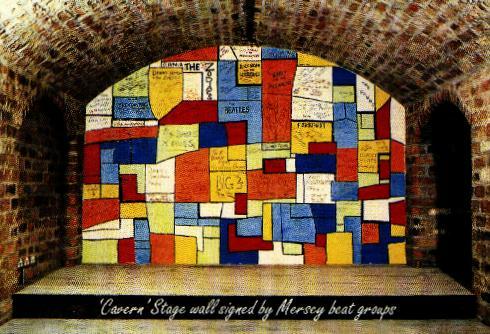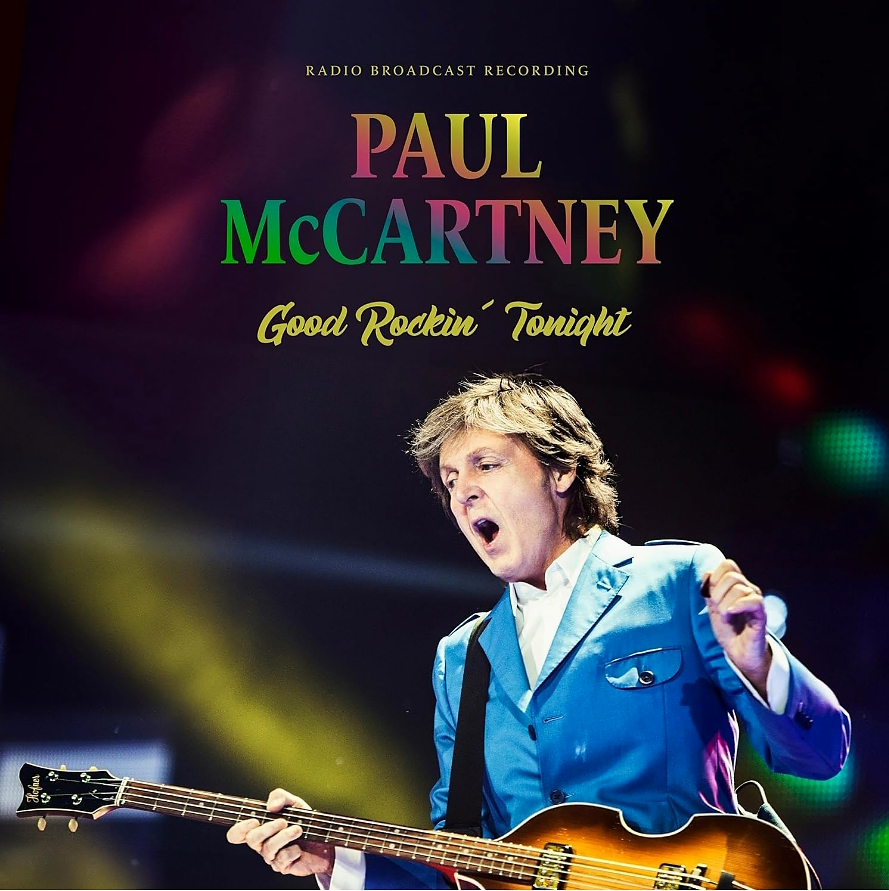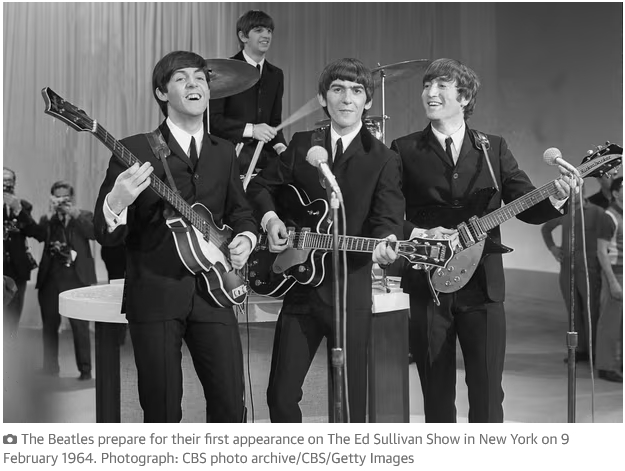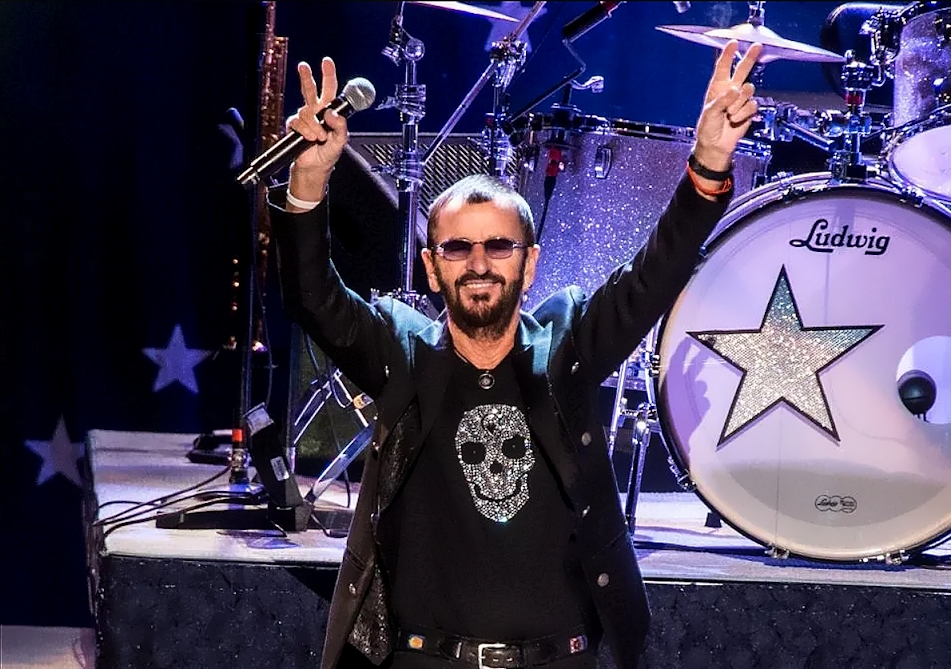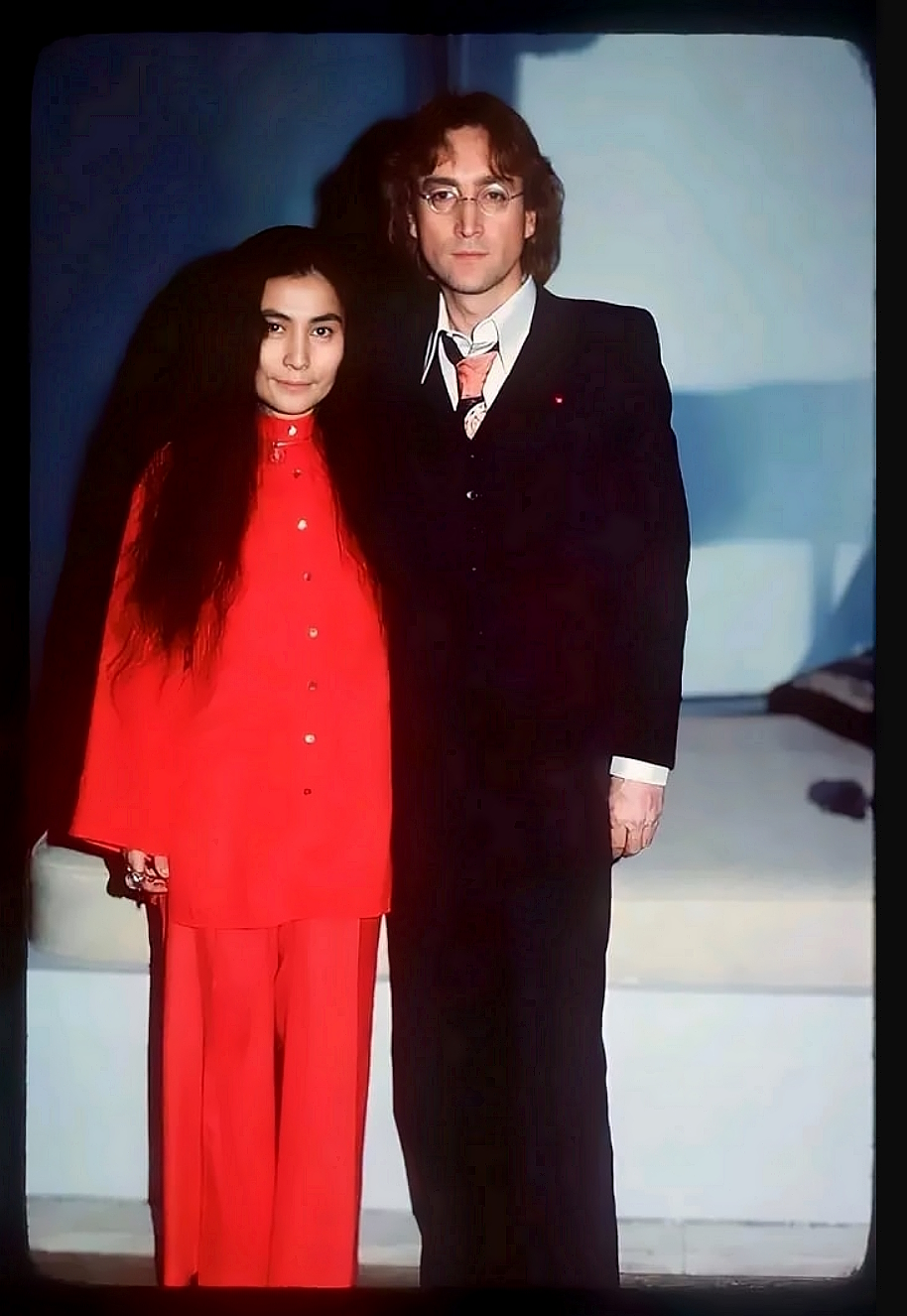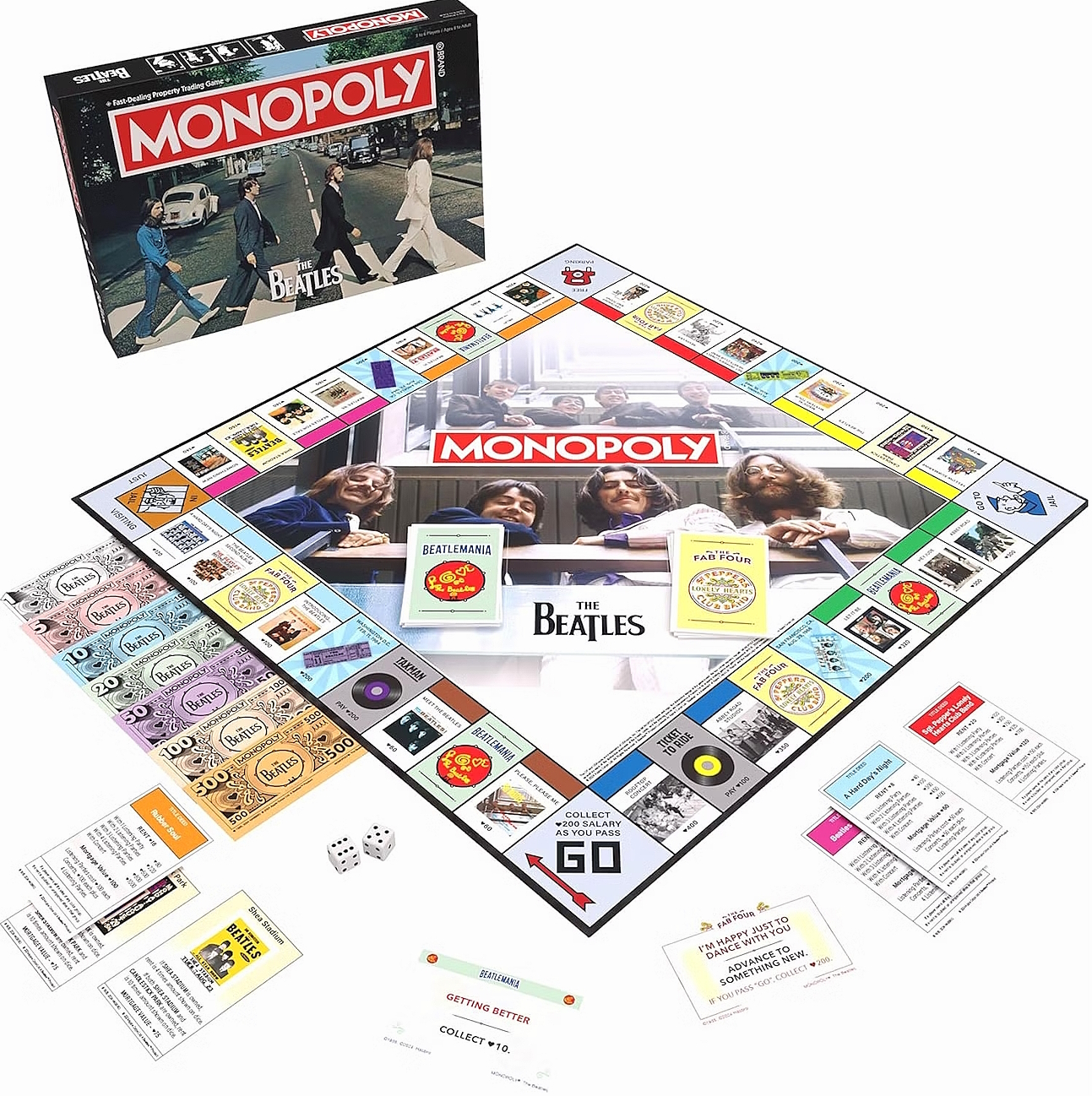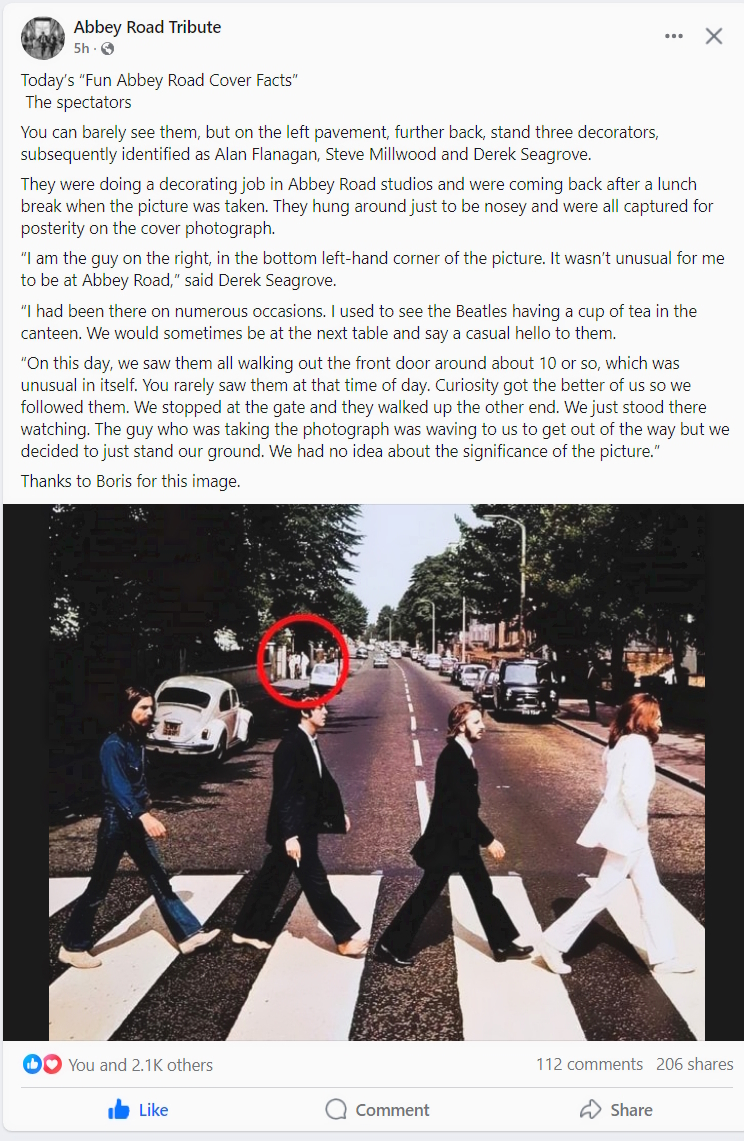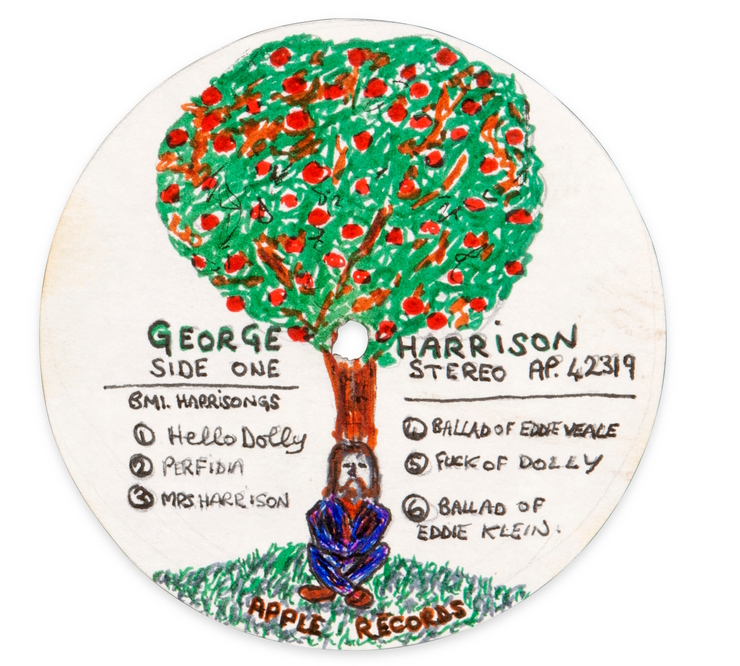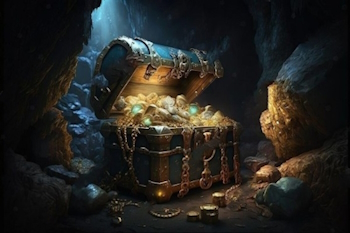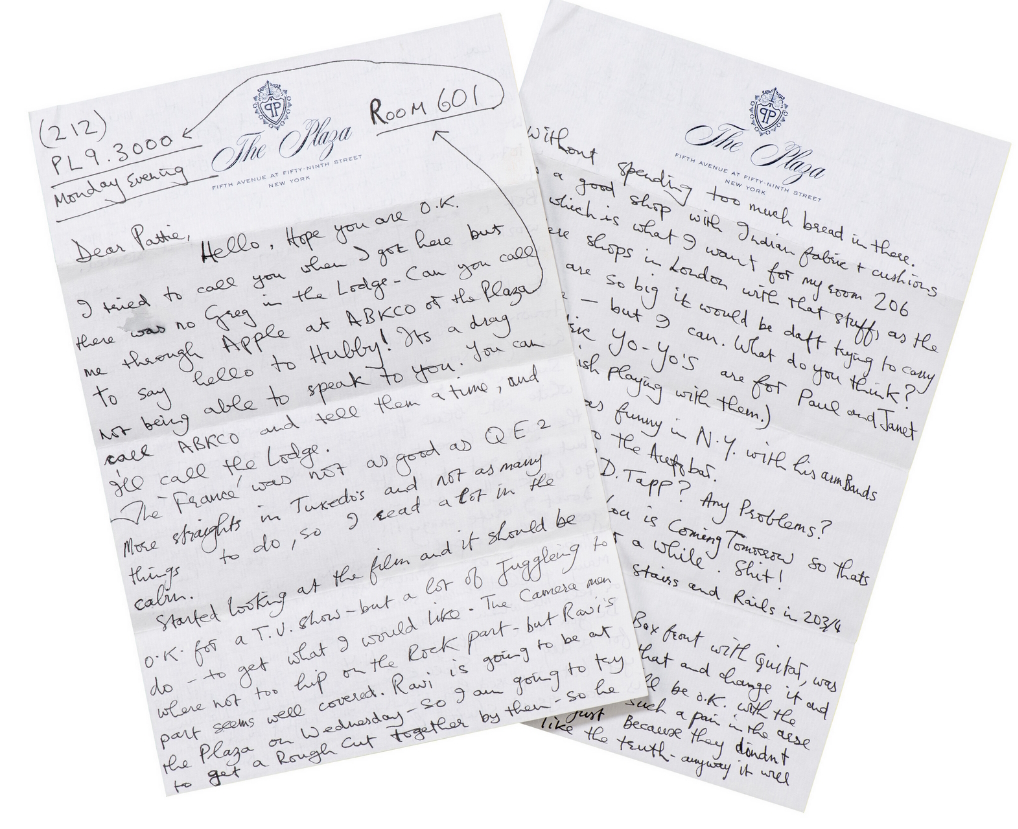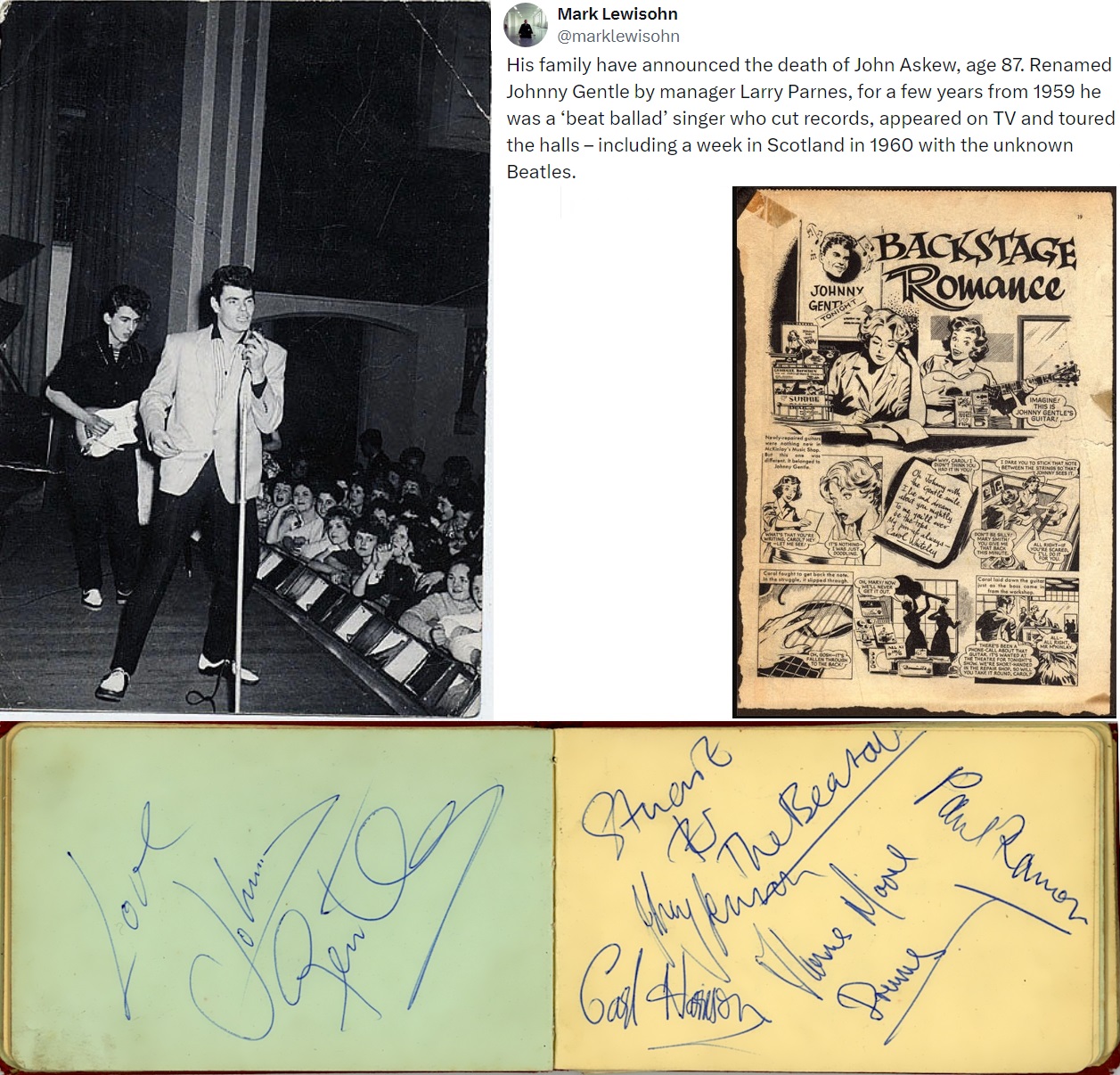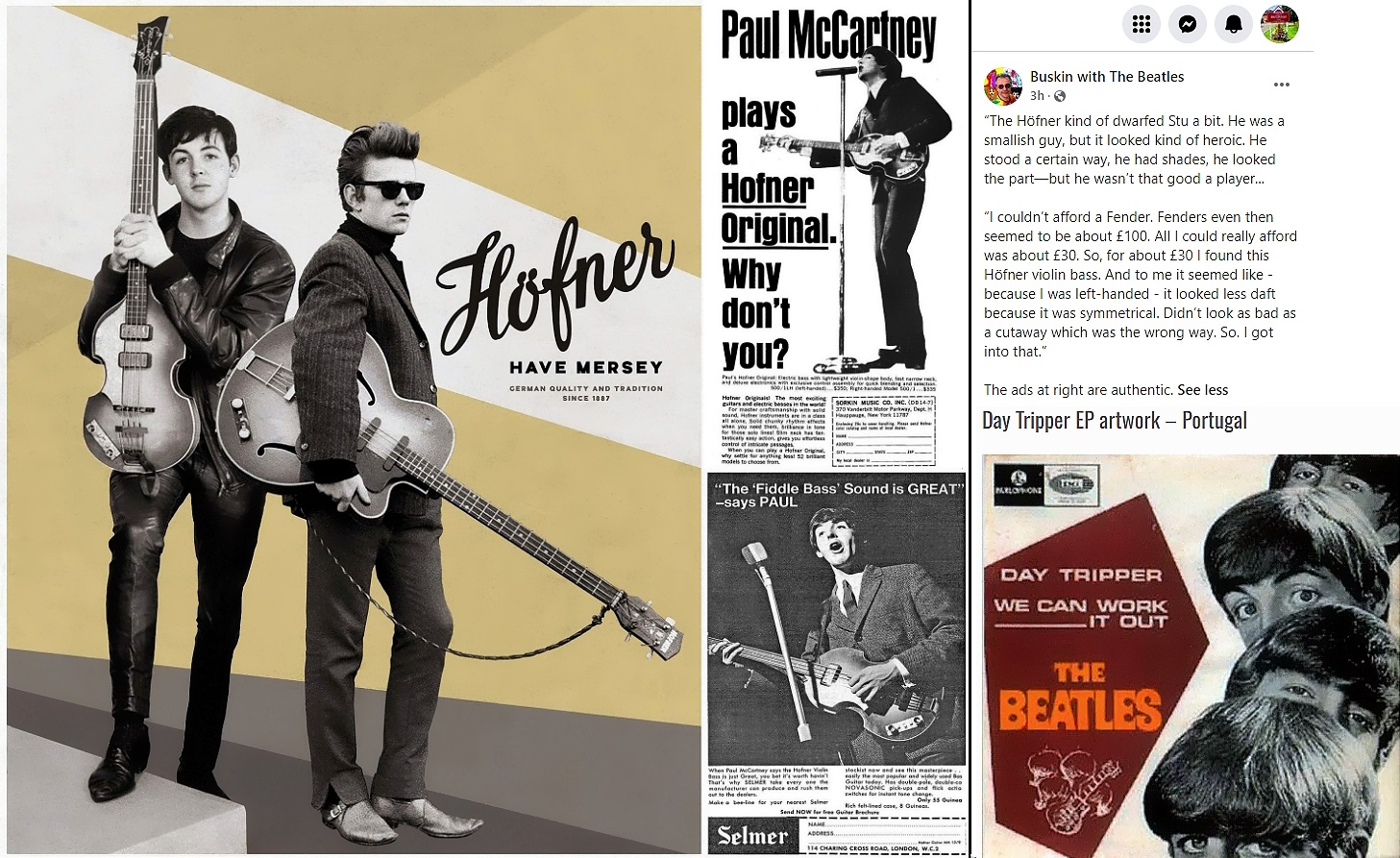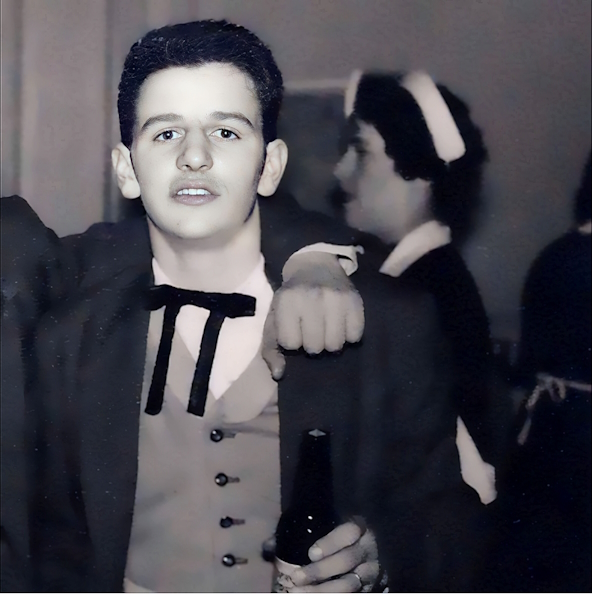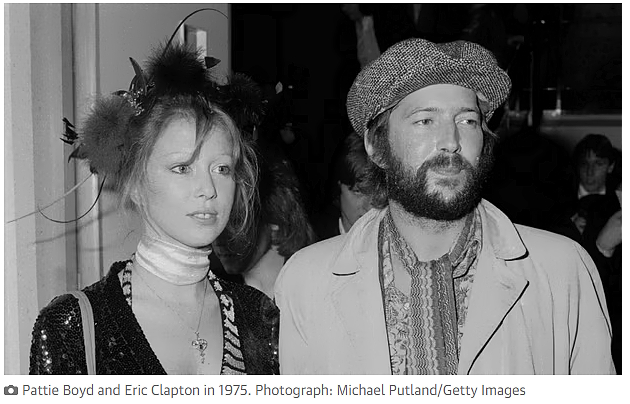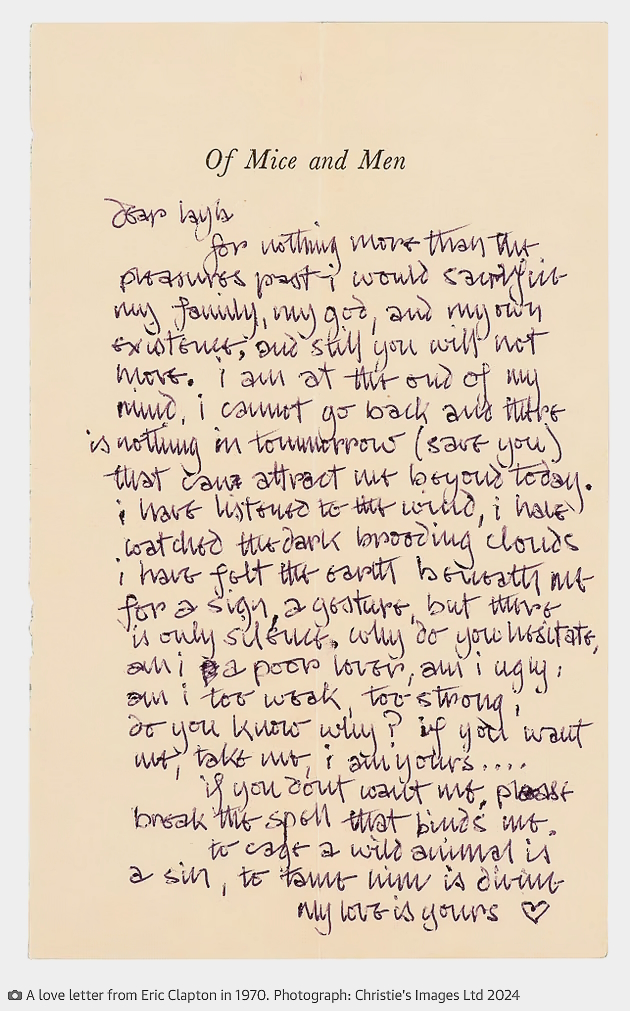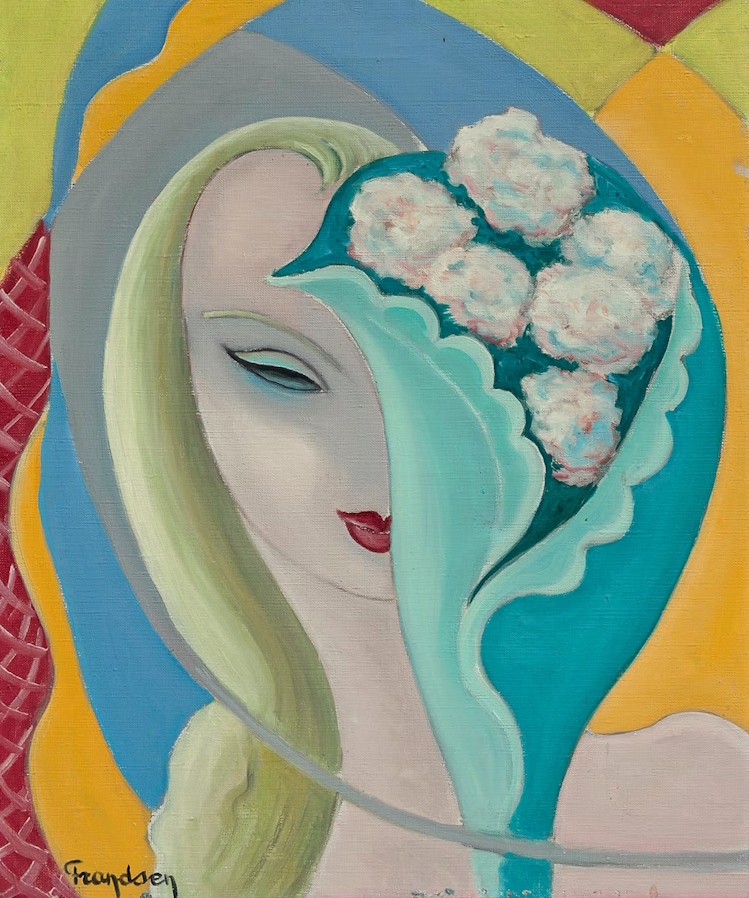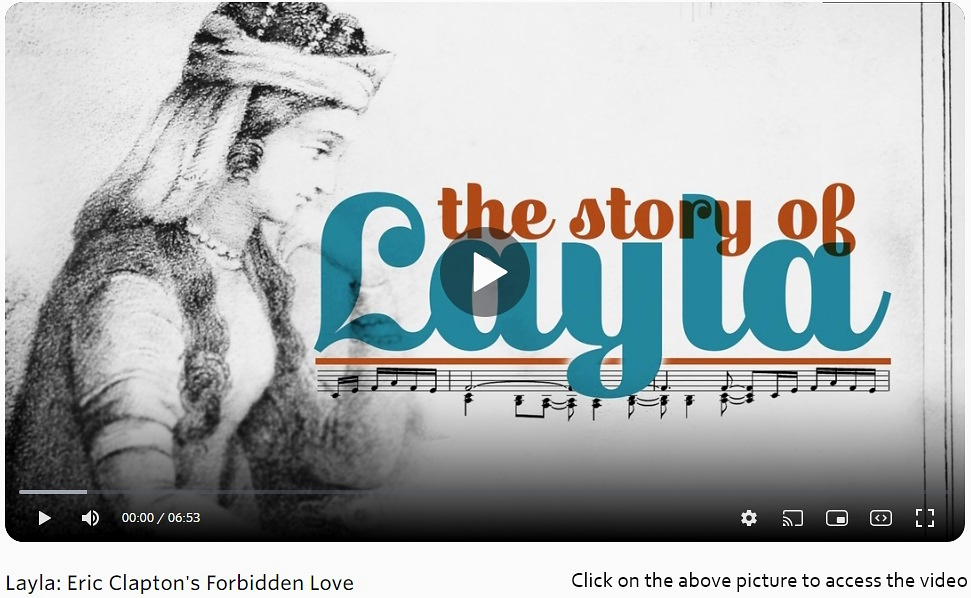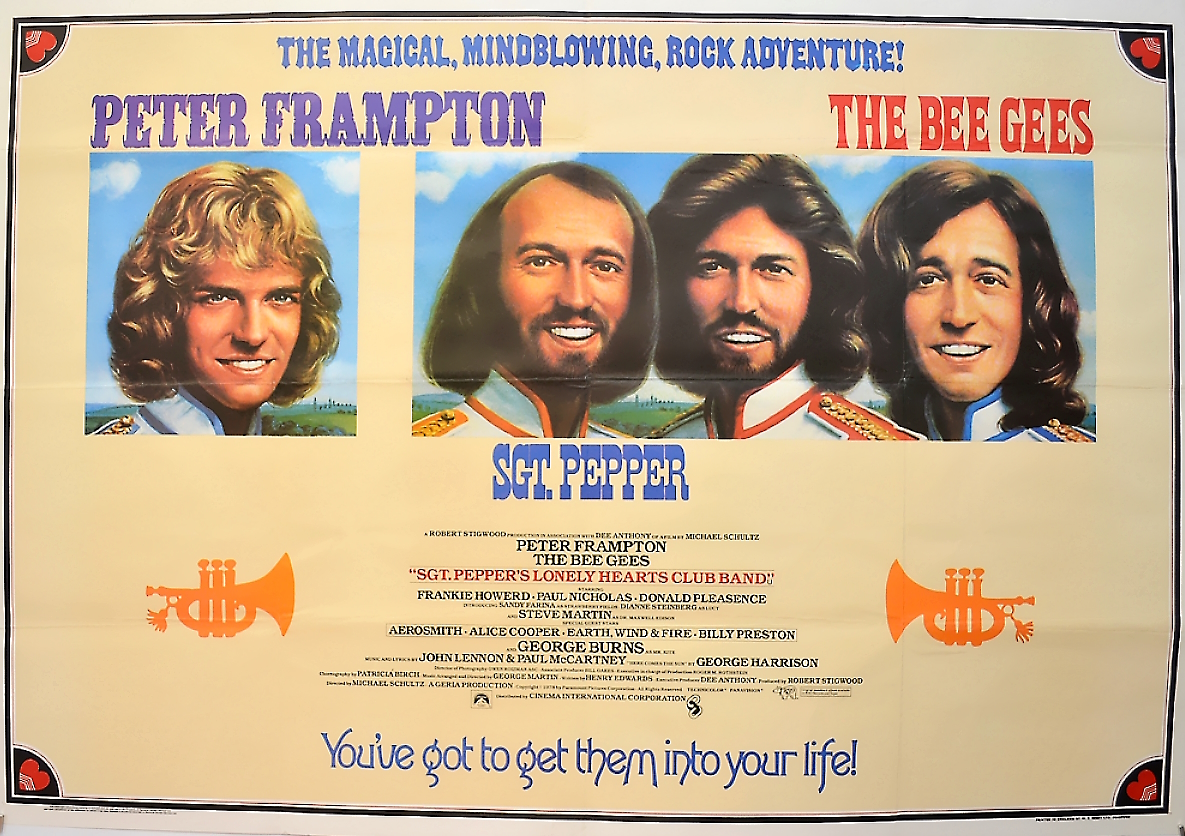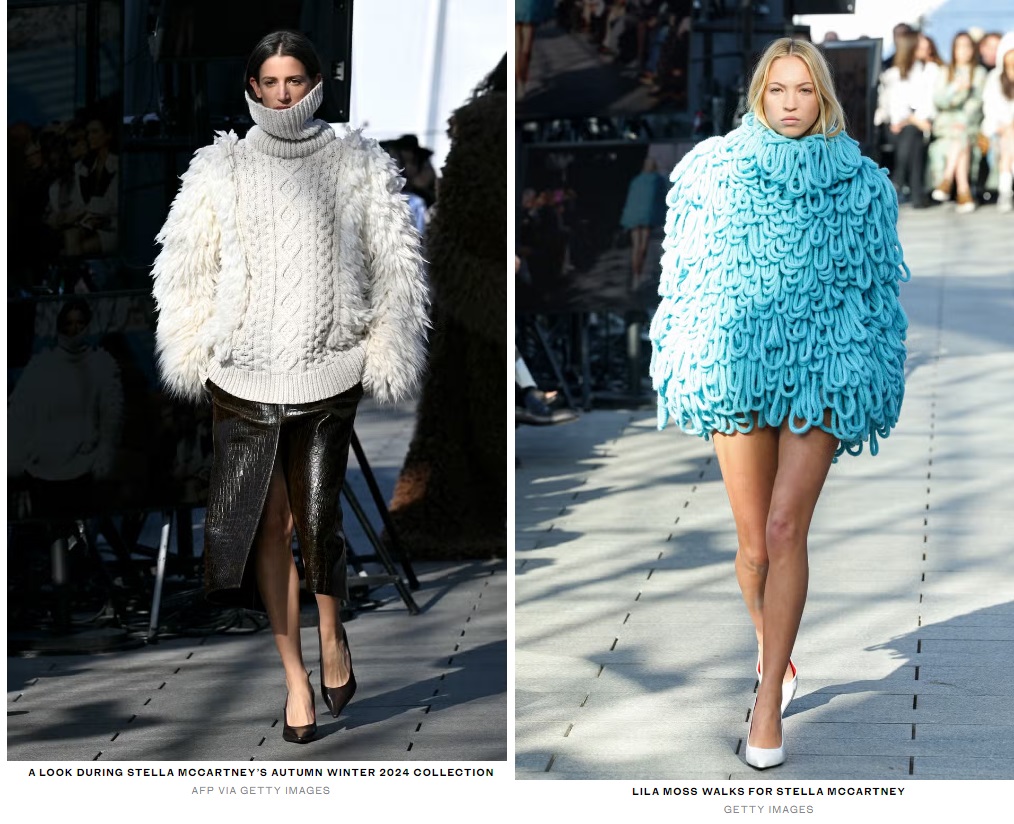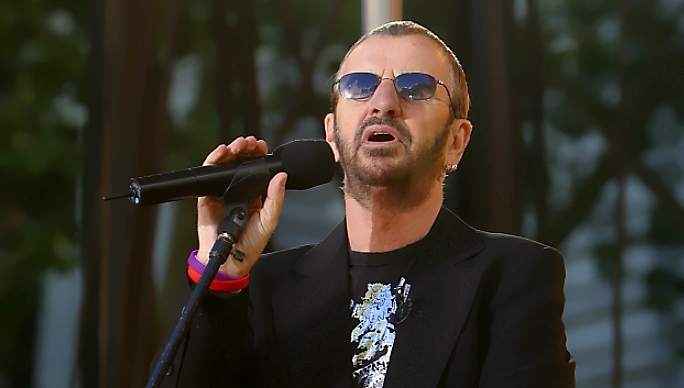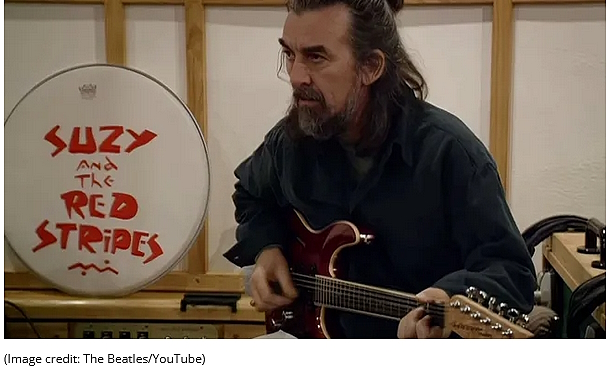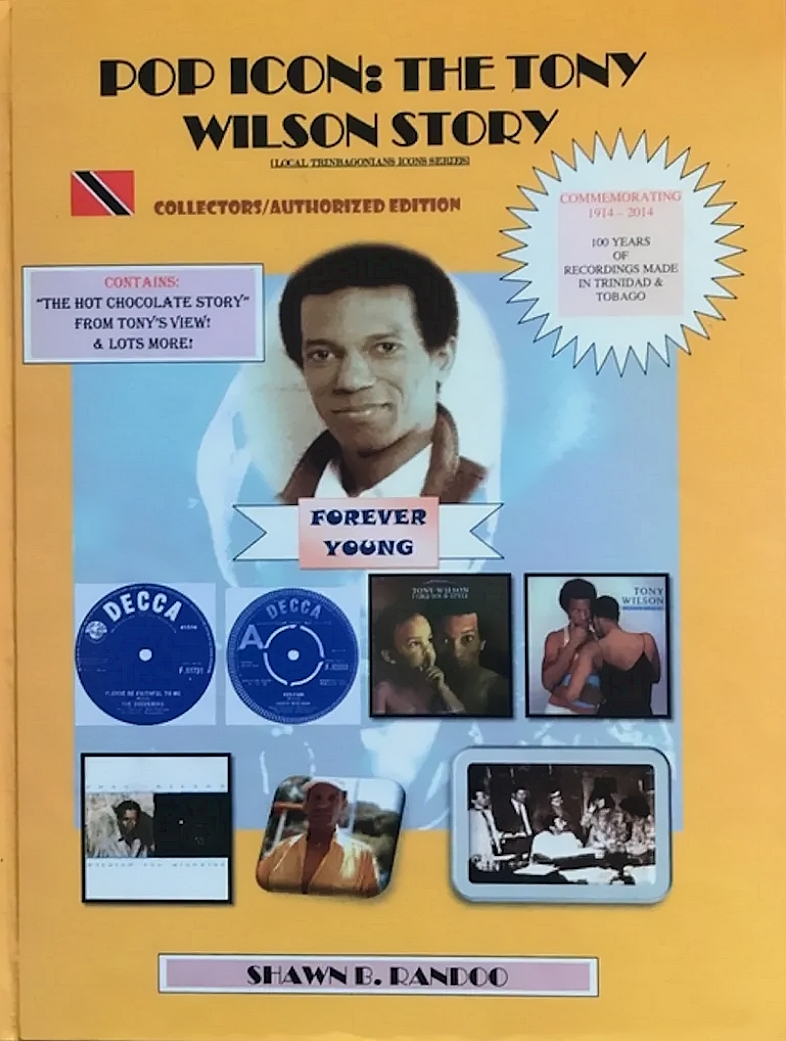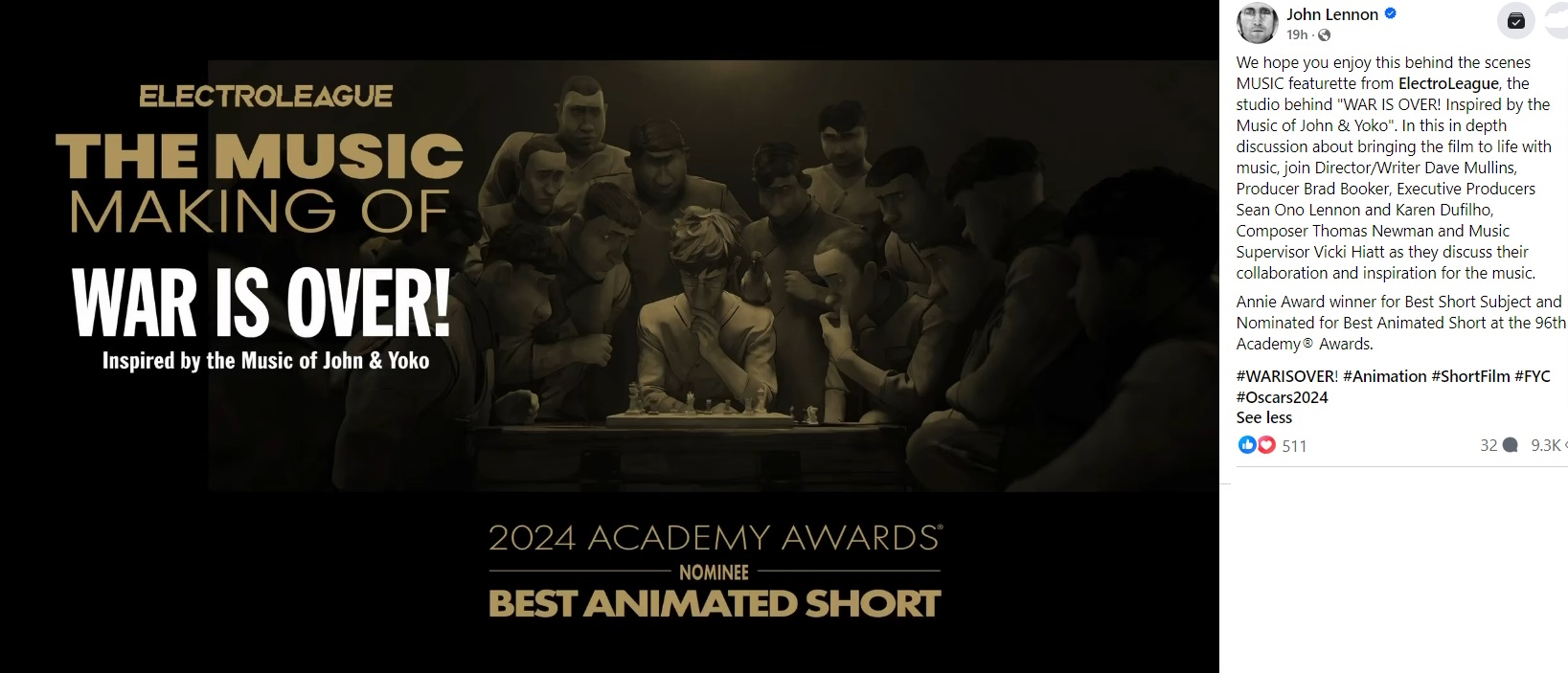|
| ||||||||||||||||||||||||||||||||||||||||||||||||||||||||||||||||||||||||||||||||||||||||
|
The News Today
March 25, 2024 Original Quarryman Colin Hanton visits George Harrison's old home From Facebook...
 March 23, 2024 "Good Rockin' Tonight" - A new limited yellow vinyl edition set for release on 29 March 2024
This strictly limited vinyl record album contains live radio broadcasts from the 80s and 90s of the legendary super-star and The Beatles member Paul McCartney including many classics and hits. Pressed on yellow wax.
Side A :
Side B :
Click here for details on how to order a copy. And just for the fun of it, here's something a little bit different that I came across on the internet: "Good Rockin' Tonight" with Elvis Presley and Paul McCartney - a fan made video... ‘An explosion of screaming and hysteria’: US fans on how they were introduced to the Beatles Four Americans on what it felt like to be swept up in Beatlemania, and reflecting on the band’s impact on their lives By Jem Bartholomew for the Guardian
What Janet DiGangi recalls most vividly about the day the Beatles came to town is eating cake and ice-cream with furious impatience. It was 12 September 1964, and DiGangi was 12, living in Boston, Massachusetts, the oldest of seven siblings. The Beatles were about to play Boston Garden but the family couldn’t leave until they’d celebrated her brother Peter’s second birthday with candles and presents.
“I was furious, because I didn’t want to be late,” recalls DiGangi, now 72. She had saved up all her babysitting money to buy the band’s second US album, Meet the Beatles! “I was so excited.” Thankfully, DiGangi made it to the show on time. It was “electric”, and sent fans wild. “It was just an explosion of screaming and hysteria,” she says.
Like many Americans who watched the Beatles arrive in the US – either on 9 February 1964 on their first Ed Sullivan Show, or those who caught their North American tour later that year – the experience for DiGangi fostered a lifelong love and fascination with the band from Liverpool. As she grew up from a schoolgirl to an adolescent to a young woman, she tagged along as the band’s sound developed, from the boys next door of A Hard Day’s Night to the mop-haired artists of Revolver to the mature and creatively fractious White Album.
Next month marks 60 years since the Beatles secured all the top five slots on the Billboard Hot 100 on 4 April 1964 – the height of Beatlemania in the US. “To look back 60 years from now, I remember things so vividly,” DiGangi says. “I totally remember watching them on television and just crying.”
DiGangi, whose favourite album is Rubber Soul, has passed on her passion for the band to the next generation, taking her niece to Abbey Road in London in 2017. “It was just as thrilling for me then as if it were 1969,” she says.
For many fans in the US, encountering the Beatles as teenagers sparked a lifelong desire to play music. Michael Shaw, a 76-year-old in Atlanta, Georgia, says he was part of the manic crowd of flailing limbs that greeted the band at Miami airport when they arrived for their second Ed Sullivan appearance, on 16 February 1964. Shaw was 16 and played lead guitar in a band called the Outcasts.
“The Beatles and the rest of the British invasion absolutely changed music and the style of music we were playing,” he says.
“I used to practise guitar four hours a day at that time, and I would sit down with my latest LP and play a song over and over trying to learn the chords,” Shaw says. As the Beatles’ sound matured, it was hard to keep up with George Harrison’s evolving style: “It really made me stretch,” he adds. Six decades on, Shaw – who says he owns a Höfner bass guitar signed by Harrison and Paul McCartney – is still in a band. They play southern rock. “I keep on trying to get my bandmates to cover some Beatles songs,” he says. Ruth Yost, 71, says she “watched the Beatles on Ed Sullivan and felt the world was changing”. Aged 12, she took along binoculars when the Beatles came to Indianapolis, Indiana, on 3 September 1964. Yost could hardly hear the music over the screams but it was enough to be in the same room with the Beatles. “I didn’t feel like myself, I felt like somebody else,” she says. “It was almost frightening, to think here I was.”
Yost became a collector of all things Beatles; her son now keeps her original LPs safe. Yost says she was a hesitant girl, the baby of a large family, and saw something of herself in George Harrison. She even dressed up as him for Halloween in 1964. “I always identified with George,” she says. “He seemed so sweet.”
Yost says the band got her through the turbulence of adolescence. “I feel like the Beatles – their music, their humour – helped a shy junior-high girl grow up through high school,” she says. The band broke up in April 1970, the year Yost graduated. “It was as if they stuck together to see me make it,” she says.
Susan Bendinelli says she saw the Beatles at San Francisco’s Cow Palace on 19 August 1964 with her older brother when she was 10. “They just had me from then on,” she says. “They had such an amazing energy, and their songs were like nothing we’d ever heard,” adding: “It was black-and-white to Technicolor.”
The seats were up in the gods and all she could see was “these four little Beatles on a stage”. She recalls being frustrated that the screaming drowned out the music. At the concert, Bendinelli, now 69, got a set of Beatles figurines – she still has Paul McCartney and Ringo Starr.
The Beatles helped her generation “find our voices”, she says. As she grew up, and the Beatles themselves became more political engaged, Bendinelli got involved in the anti-nuclear and anti-war movements, protesting against the US war in Vietnam, and promoting sustainability through Earth Day and local environmental activism.
“All through my life I’ve been an activist. And I don’t know if I would have done that if I hadn’t had those experiences when I was really young and watched the Beatles become activists as well,” she says. “They definitely created a foundation for me that I still feel I walk on.”  March 22, 2024 Ringo Starr Could Chart A New No. 1 Hit In His Home Country Next Week By Hugh McIntyre, Senior Contributor for Forbes
Ringo Starr is already one of the most successful musicians of all time in the U.K., but that track record doesn’t mean he’s done creating. The drummer, singer, and songwriter has a new tune out with a bevy of other superstars, and it could hit No. 1 in the U.K., giving him another winner…at least, in some regards.
The former Beatle is one of the many members
of the rock supergroup Mark Knopfler's
Guitar Heroes, which was put together by the
Dire Straits frontman and solo star whose
name fronts the band. The rocker gathered
together many of his famous friends to
re-record a new version of the song “Going
Home (Theme From Local Hero),” which is
currently making a play for the No. 1 spot
on the U.K. singles chart, according to the Official
Charts Company. “Going Home (Theme From Local Hero)” is a new superstar collaboration that’s aimed at raising funds for a worthy cause. All proceeds from the tune will go toward supporting both Teenage Cancer Trust UK and Teen Cancer America. The mix of celebrity names and the charitable aspect mean the track has a lot going for it, and it could debut at No. 1 in the U.K.
Mark Knopfler's Guitar Heroes counts more than 50 musicians as members, though it’s likely that this will be their only release together. Starr is credited as playing drums on the tune. He is joined by dozens of other well-known names on the song, such as Eric Clapton, Sheryl Crow, Peter Frampton, Joan Jett, Nile Rodgers, Bruce Springsteen, Sting, Keith Urban, and many, many others.
It’s important to note that these artists aren’t simply session musicians, but rather actual members of a new group. They’re all part of Mark Knopfler's Guitar Heroes, so if “Going Home (Theme From Local Hero)” hits No. 1 in the U.K., they all collect a new No. 1–or at least that’s how things should go.
Oftentimes, when it comes to these
kinds of charity singles, artists don’t
count the successes they’re involved in as
part of their discography. Fundraising
releases are more common in the U.K. than in
the U.S., and there are many musicians who
have hit No. 1 with charity offerings, but
whose pages on the Official Charts
Company –the country’s version of Billboard– don’t
include those wins in their career totals.
It’s a bit of an odd loophole in the chart
system, but people largely overlook it as
the point is to raise money, not score a
hit.
 March 20, 2024 The Beatles’ Monopoly Board Game Has Been Updated For 2024 By That Eric Alper
For Beatles enthusiasts and Monopoly collectors alike, a new edition of The Beatles Monopoly board game has been announced, set to release in 2024. This updated edition promises a unique fusion of nostalgia and entertainment, seamlessly blending the classic charm of MONOPOLY with the timeless appeal of The Beatles. You can now get it here.
Players will have the opportunity to relive the magic of The Beatles’ iconic album covers as they navigate the game board. Featuring stunning visuals that pay homage to the band’s legendary discography, each square is a tribute to the Fab Four’s illustrious career.
Custom components tailored to The Beatles theme include 6 collectible tokens inspired by popular song titles such as “Here Comes the Sun” and “I Am the Walrus.” Additionally, players will encounter 28 Title Deed Cards featuring albums and concert tickets, 16 “The Fab Four” cards, and 16 “Beatlemania” cards. Custom Monopoly money adorned with Beatles imagery adds to the immersive experience.
One of the highlights of the game is the inclusion of 32 houses renamed “Listening Parties” and 12 hotels renamed “Concerts,” allowing players to build their Beatlemania empire as they progress through the game.
The release of this updated edition also features new sculpted tokens, including “Maxwell’s Silver Hammer,” “Strawberry Fields Forever,” “Rocky Raccoon,” and “Octopus’s Garden,” providing players with a unique tactile experience.
Players will have the opportunity to buy, sell, and trade their way through Beatlemania as they collect famous albums such as “A Hard Day’s Night,” “Revolver,” “Sgt. Pepper’s Lonely Hearts Club Band,” “Abbey Road,” and many more.
With its immersive gameplay and homage to The Beatles’ timeless music, this new edition of The Beatles Monopoly board game is sure to be a must-have for fans and collectors alike, offering hours of nostalgia-filled entertainment.  March 19, 2024 Introducing The Pre-Amps The Pre-Amps are a 4-piece British Retro-influenced Pop/Rock band from Newcastle upon Tyne, England. They specialise in performing covers from the 1960s, covering the likes of The Beatles, The Kinks, The Byrds, Roy Orbison, The Hollies, Jeff Beck and The Monkees to name but a few, whilst combining distinctive 1960s-style vocal harmonies and retro Rock & Roll instrumentation to create a real nostalgic experience that’s sure to get you up dancing! Known nationwide for their impressive vocal harmonies and their up-beat, feel-good choice of material, The Pre-Amps made a big impression on the North East music scene whilst touring the local pub/club circuit since they left 6th Form College in 2017 and spent time furthering this in the North West during 2017-2020 whilst studying Music Production at Edge Hill University in Ormskirk, Lancashire. The group is currently playing regularly at various venues across the UK where they are continuously gaining a solid reputation as a hard-working, professional and entertaining live act. They gained great exposure after playing on the front stage at the world-famous Cavern Club, Liverpool for the first time in March 2018 and supported the Small Fakers in the Cavern Club Live Lounge in March 2019, subsequently being asked to return by the venue on several occasions.
THE PRE-AMPS PERFORMING AT THE CAVERN CLUB IN MARCH 2018 In August 2022, The Pre-Amps played on the same bill as The Quarrymen, The Merseybeats and The Pete Best Band at 'Best Fest' at The Casbah Coffee Club in Liverpool and were a big hit with the audience. The band are currently enjoying delving into the Warner Leisure Hotels circuit as well as the likes of Haven and Pontins holiday parks and are garnering high praise from both staff and audience members alike. The band’s self-produced 2017 and 2019 ‘Covers’ albums have been received very well and have been highly praised worldwide for capturing the essence of the times and reminding people of “the good old days”. The Pre-Amps’ first original single ‘Doesn’t Change’ was released on The Label Recordings on 19th December 2019 and received a great deal of national airplay on stations such as BBC Radio Newcastle, BBC Radio Merseyside and BBC Radio London. The track also gained numerous positive reviews and online press coverage.The band has since released lots more original music which can be found on all streaming platforms. https://open.spotify.com/artist/69edSw5hQC6RbQ8BbR5Xrs Other suspects of interest from the Abbey Road album cover as published on the Abbey Road Tribute Facebook page...
 March 18, 2024 The Story Behind “Eight Days a Week” by The Beatles, Which Topped the Charts 59 Years Ago By Matt Friedlander for American Songwriter The Beatles’ classic pop hit “Eight Days a Week” reached No. 1 on the Billboard Hot 100 on March 13, 1965. The song was the Fab Four’s seventh single to top the Hot 100 in just over a year, the first being “I Want to Hold Your Hand,” which peaked at No. 1 in February 1964.
“Eight Days a Week,” which spent two weeks at the top of the Hot 100, replaced and was replaced, respectively, by a pair of classic Motown tunes— The Temptations’ “My Girl” and The Supremes’ “Stop! In the Name of Love.”
“Eight Days a Week” wasn’t issued as a single in the U.K., and made its first appearance as a track on the 1964 U.K. album Beatles for Sale. In the U.S., the song was released as a single in February 1965, and later appeared on the 1965 U.S. album Beatles VI.
The song was mainly written by Paul McCartney, with some help from John Lennon. The tune may have come together as McCartney’s attempt to write a song for The Beatles’ second movie, Help!, which originally had the working title Eight Arms to Hold You. McCartney Told Conflicting Stories About the Song Title’s Origin Over the years, McCartney told two different stories about what inspired the song’s title.
In a 1984 interview with Playboy, he credited Ringo Starr with coming up with the title. (Starr was known to have been the source for the quirky titles of such other Fab Four tunes as “A Hard Day’s Night” and “Tomorrow Never Knows.”)
“[Ringo] said it as though he were an overworked chauffeur. ‘Eight days a week,’” McCartney told the magazine with a laugh. “When we heard it, we said, ‘Really? Bing! Got it!’”
In the 1995 Beatles Anthology docuseries, McCartney said he got the title from a comment made by a chauffeur who was driving him to a songwriting session at Lennon’s home.
“[T]he chauffeur drove me out that day and I said, ‘How’ve you been?’ … ‘Oh, working hard,’ he said, ‘working eight days a week,’” McCartney recalled. “I had never heard anyone use that expression, so when I arrived at John’s house I said, ‘Hey, this fella just said, “eight days a week”.’ John said, ‘Right … Ooh I need your love, babe,’ and we wrote it.” “Eight Days a Week” Had a Unique Intro “Eight Days a Week” is credited with being the first pop song to feature a fade-in introduction. The Beatles recorded several takes of the song with different intros, including one featuring an a cappella harmony part by Lennon and McCartney. A number of the different takes were included on the 1995 Anthology 1 compilation. The Beatles Never Played the Song Live, but McCartney Did The Beatles never performed “Eight Days a Week” in concert, although the band once mimed the tune during a March 1965 appearance on the U.K. TV show Thank Your Lucky Stars.
McCartney dusted the tune off and played it more than 80 times at his concerts in 2013, 2014, and 2015.
Lennon Didn’t Like the Song In one of his last interviews, with journalist David Sheff in 1980, Lennon said he disliked “Eight Days a Week.”
“‘Eight Days A Week’ was never a good song,” he said. “We struggled to record it and struggled to make it into a song. It was [McCartney’s] initial effort, but I think we both worked on it. I’m not sure. But it was lousy anyway.” Cover Versions Among the artists who have covered “Eight Days a Week” over the years are Mary Wells, Procol Harum, The Runaways, Lorrie Morgan, The Persuasions, and The Dandy Warhols.  March 16, 2024
In 1965, the pop duo of Chad and Jeremy gave a big nod to Beatles manager Brian Epstein in a song called "The Girl Who Sang The Blues." We also add a second track entitled "The Woman In You." Both songs are from the album "I Don't Want To Lose You Baby" on Columbia Records.  March 15, 2024 'Mystery man' on The Beatles' famous Abbey Road album pulls off world's greatest photobomb The Beatles' Abbey Road album cover is one of the most iconic in the world - and it features a man who accidentally photobombed the Fab Four as they walked across a zebra crossing By Paige Freshwater, Content Editor and Vicki Newman, Assistant Showbiz Editor for the Mirror
The 'mystery man' on the cover of The Beatles' famous Abbey Road album ended up being part of the world's most epic photobomb. We've all jumped into a photo for fun when we're out and about. But this guy became part of music history without even trying.
On the front of The Beatles' Abbey Road record from 1969, you can see the band crossing a road in a line. But if you look closely, there's a man standing by the road in the background. He's one of the few people caught in the snap, and he didn't mean to be there.
This man, dressed in a brown coat and white shirt, was found years later after numerous people came forward claiming to be him. He's actually an American tourist called Paul Cole, who was waiting for his wife when the picture was taken. He told The Mirror: "[I told her] 'I've seen enough museums. I'll just stay out here and see what's going on outside'."
Just then, he saw four guys walking over the zebra crossing and noticed something odd - one of them, Paul McCartney, had no shoes on! He remarked: "I just happened to look up, and I saw those guys walking across the street like a line of ducks. "A bunch of kooks, I called them, because they were rather radical-looking at that time. You didn't walk around in London barefoot." Paul was amazed when he later spotted himself in the background on an album cover.
He said: "I saw the album and I recognised myself right away. I had a new sports jacket on and I'd just bought new shell-rimmed glasses. I told my kids, 'Get a magnifying glass out and you'll see me'." Sadly, Paul passed away in 2008, when he was 98 years old.
 March 14, 2024 Johnny Gentle - singer who was backed by The Beatles - dies, aged 87 Johnny Gentle was backed on a tour of Scotland by The Silver Beetles. By Gold staff
John Askew, known to pop fans of the 1950s and 1960s as Johnny Gentle, has died at the age of 87. Gentle's passing was announced by his family with a death notice in the Liverpool Echo. "We are sad to announce the passing of our beloved John; loving husband to Jane, brother to Joan (deceased) & Anne, father to Donna & Gavin, stepfather to Katherine & James and Pop to Daniel, Bayly, Ellie, Chloe, Celyn, Tilly & Darcie," read the notice.
"John will be hugely missed by his family and friends in Beckenham/Bromley, Greater London and his birthplace and home town of Liverpool. "He will be remembered by music fans as the singer Johnny Gentle, one of Larry Parnes' stars of the late fifties, even having the Beatles as his support band on their first-ever tour!" Born on December 8, 1936 in Liverpool, Gentle had apprenticed as a carpenter and even made his own guitar when he started performing.
He performed in local clubs and at sea, and it was Parnes who gave Gentle his stage name and got him signed to Philips Records in 1959.
After some unsuccessful releases, Parnes chose The Silver Beetles – John Lennon, Paul McCartney, George Harrison, Stuart Sutcliffe and drummer Tommy Moore – to be Gentle's backing band on a tour in Scotland.
It was the first tour of the band that would later conquer the world as The Beatles, and saw the group play Alloa, Inverness, Fraserburgh, Keith, Forres, Nairn and Peterhead between May 20 and 28, 1960.
Gentle sang once with the group back in Liverpool, but by the time of his next tour The Beatles had travelled to Hamburg.
He continued to release singles, including a version of his own 'I've Just Fallen For Someone' – a song he had previously given to Adam Faith – under a new stage name of Darren Young.
After his music career, Gentle worked as a joiner, and later co-wrote the book Johnny Gentle & the Beatles: First Ever Tour, recounting his time with the Fab Four.
− End of article.
Johnny Gentle (a.k.a. Darren Young a.k.a. John Askew) co-wrote 'I've Just Fallen For Someone' with John Lennon (uncredited) in May 1960. At this time, The Beatles, John Lennon, Paul McCartney, George Harrison, Stuart Sutcliffe and Tommy Moore, performing as The Silver Beetles, were Johnny Gentle's backing group for his 1960 tour of Scotland. "Gentle wrote a song on the tour, "I've Just Fallen For Someone", reputedly with help from Lennon. The song was later recorded by Adam Faith on his second album." (from Wikipedia). According to Gentle, John Lennon wrote the bridge of the song. Click on the Youtube video "Liverpool Sounds" to hear the story from Johnny Gentle.  March 13, 2024 Promotional ads for the Hofner bass guitar + Beatles feature "Day Tripper"
 March 12, 2024 When You Wish Upon A Starr...
 March 11, 2024 By Andrew of Parlogram Auctions Making a children's song is always a gamble for a major artist but Paul McCartney did just that in 1984. Released in the wake of the disastrous 'Give My Regards to Broad Street' film, 'We All Stand Together' (aka The Frog Song) was a major hit in the UK but was not released in the U.S. at the time. In this video we look at the events leading up to is release, including Paul's trouble with the police and British tabloid press and a loose-tongued former band mate. In addition to covering its composition, we also look at the Rupert The Bear character and the cartoon film it was taken from. There's so much in this one, we think you'll need to watch it at least twice. Links to other YouTube videos mentioned in this video: We All Stand Together (song video): https://youtu.be/gVfaf43W9cM?si=fhKnS... Rupert & The Frog Song (animated featurette): https://youtu.be/n5uzrOFwOZ8?si=7Hm-Y... We All Stand Together (demo): https://youtu.be/kdStv7XDE5c?si=PH065... Jackie Lee - Rupert The Bear (TV Theme): https://youtu.be/rY1aJ35sw98?si=il1BT... Other links: Split your favourite tracks into stems with La-La-Lai: https://www.lalal.ai/?fp_ref=andrew69 Say Hello To Paul McCartney (Yoto card): https://uk.yotoplay.com/products/paul... Rupert Bear Annual book: https://www.amazon.co.uk/Rupert-Annua... Rupert Bear scarf: https://www.amazon.co.uk/Rupert-Bear-...  March 10, 2024 Congratulations to Sean Lennon, Dave Mullins, Brad Booker and the entire production team for winning an Oscar for "Best Animated Short"
WAR IS OVER! Inspired by the Music of John & Yoko snagged best animated short at the ceremony. By Hannah Dailey for Billboard Sunday (March 10) marked the date of the 2024 Oscars, but it’s also Mother’s Day in the U.K. And during Dave Mullins and Brad Booker’s emotional best animated short win for WAR IS OVER! Inspired by the Music of John & Yoko, Sean Ono Lennon — the son of Yoko Ono and late Beatles legend John Lennon — made sure to give his mom an extra special shout-out. Ono Lennon, who served as an executive producer on the short film, took the stage at Dolby Theatre in Los Angeles alongside Mullins and Booker. After the director and producer gave their acceptance speeches, Sean squeezed in a tribute to Yoko Ono — even though the “wrap-it-up” music was already playing. “My mother turned 91 this February,” he told the crowd. “Can everyone say ‘happy Mother’s Day to Yoko’?” At his request, the audience in front of him wished the “Give Peace a Chance” artist a happy holiday in unison.
Sean is Ono and John Lennon‘s only child, born in 1975. The famed artist is also mom to a daughter, Kyoko Chan Cox, whom she shares with her ex-husband, film producer Anthony Cox, while John also had son Julian Lennon from his marriage to first wife Cynthia.
According to IMbD, WAR IS OVER! — which Sean co-wrote with Mullins but who is not a winner for the Oscar — is set at a World War I front, where “a carrier pigeon delivers moves messages between two soldiers playing a chess game, unaware they are on opposite sides.”
Ono and her late husband collaborated a number of times before Lennon was fatally shot in 1980, notably on “Happy Xmas (War Is Over).” The track has gone down in history as a classic Christmas tune, reaching its latest peak of No. 38 on the Billboard Hot 100 in 2022 — more than 50 years after it was first released.
− End of article. The First Time The Beatles Let Down Producer George Martin George Martin got to know The Beatles well over the years. While he usually liked them, they once let him down. By Emma McKee for Showbiz Cheatsheet
The Beatles’ longtime producer George Martin worked with them on each album they put out in the 1960s. He was a key part of their success and got to know them well throughout their collaboration. Their antics, particularly in the early 1960s, grew familiar to him. Still, they sometimes pushed Martin too far. He shared what they did to let him down for the very first time. The Beatles frustrated George Martin while recording songs in German In the early 1960s, The Beatles traveled to Paris for a concert. While they were there, Martin booked them studio time to record German language versions of “She Loves You” and “I Want to Hold Your Hand.” A record company executive believed there was no chance the songs would sell in Germany if they were in English. “I was disinclined to believe this, but that’s what he said and I told The Beatles,” Martin said in The Beatles Anthology. “They laughed: ‘That’s absolute rubbish.’ So I said, ‘Well, if we want to sell records in Germany, that’s what we’ve got to do.’ So they agreed to record in German. I mean, really it was rubbish, but the company sent over one Otto Demmlar to help coach them in German.” Demmlar and Martin waited for The Beatles in the studio on the day they were meant to record, but they never arrived. “It was the first time in my experience with them that they had let me down, so I rang the George V Hotel where they were staying, and Neil Aspinall answered,” Martin said. “He said, ‘I’m sorry, they’re not coming, they asked me to tell you.’ I said, ‘You mean to tell me they’re telling you to tell me? They’re not telling me themselves?’ — ‘That’s right.’ — ‘I’m coming right over,’ I said.” A furious Martin rushed to the hotel Martin arrived at the George V Hotel to find the band having tea with Paul McCartney’s girlfriend, Jane Asher.
“So I went to see them and I had Otto with me,” Martin said. “I was really angry and stormed in to find they were all having tea in the center of the room. (They were, after all, very charming people.) It was rather like the Mad Hatters Tea Party with Alice in Wonderland in the form of Jane Asher, with long hair, in the middle pouring tea.”
When the band saw Martin, their reaction was enough to mollify his frustration.
“As soon as I entered they exploded in all directions, they ran behind couches and chairs and one put a lampshade over his head,” Martin said. “Then from behind the sofa and chairs came a chorus of: ‘Sorry George, sorry George, sorry George…’ I had to laugh. I said, ‘You are bastards, aren’t you? Are you going to apologize to Otto?’ And they said, ‘Sorry Otto; sorry Otto.’” The Beatles proved to George Martin that their records would sell in English Ultimately, Martin was able to wrangle them into the studio to record the German versions of their songs. As it turned out, though, they had all been correct in thinking it was unnecessary. The English versions did well. “They finally agreed to come down to the studio and work,” Martin said. “They did record two songs in German. They were the only things they have ever done in a foreign language. And they didn’t need to anyway. They were quite right. The records would have sold in English, and did.”  March 9, 2024 ‘Am I a poor lover, am I ugly?’ Eric Clapton letters reveal details of George Harrison love triangle Auction of items owned by Pattie Boyd, ex-wife of Harrison then Clapton, reveals passionate overtures from rock star By Ben Beaumont-Thomas for the Guardian
Deeply heartfelt and revealing letters from Eric Clapton to Pattie Boyd while she was married to George Harrison are to be sold at auction, laying bare one of rock’s most notorious love triangles.
Boyd was a model and an icon of swinging London in the 1960s, marrying Harrison in 1966 after meeting him on the set of Beatles film A Hard Day’s Night – she claimed he wrote the Beatles ballad Something about her, though he later denied it. Towards the end of the decade Harrison and Clapton began writing music together, and Clapton became besotted with Boyd.
In a 1970 letter, part of a lot of Boyd’s possessions being sold by Christie’s from 8 to 21 March, Clapton – with impeccable penmanship – beseeches Boyd: “What I wish to ask you is if you still love your husband, or if you have another lover? All these questions are very impertinent I know but if there is still a feeling in your heart for me… you must let me know!” He refers to his own “home affairs” as “a galloping farce”: Clapton was dating Boyd’s sister Paula while ostensibly in a relationship with aristocrat Alice Ormsby-Gore.
Speaking to Christie’s, Boyd said she initially “thought it was a letter from a weird fan”, and only realised after Clapton followed up on the phone. Clapton wrote another letter a few months later, on a title page torn from a copy of Of Mice and Men. “For nothing more than the pleasures past I would sacrifice my family, my god and my own existence … I am at the end of my mind … I have listened to the wind, I have watched the dark brooding clouds I have felt the earth beneath me for a sign, a gesture, but there is only silence. Why do you hesitate, am I a poor lover, am I ugly; am I too weak, too strong, do you know why? If you want me, take me, I am yours. If you don’t want me, please break the spell that binds me. To cage a wild animal is a sin, to tame him is divine. My love is yours.” Each of the letters is estimated to sell for between £10,000 and £15,000.
He refers to Boyd as “Layla” and that year wrote the classic rock song of the same name about her. After he played her a cassette recording of Layla, Boyd says: “I was taken aback by its beauty – but at the same time I felt guilt.”
Boyd elaborates on her feelings at the time. “George and I were going through a bit of a spiky time together. The Beatles had this chaos and anxiety surrounding the band, and George was being dismissive. Then Eric keeps coming over to our house asking me to run away with him. Well, that was tempting, but I couldn’t do it. It just wasn’t right.”
Boyd and Harrison split in 1974 due to his multiple infidelities. She and Clapton barely saw each other until the middle of the decade, when they reconnected and eventually married in 1979. He wrote other songs about her, including Wonderful Tonight, a doting ballad written during – and about – Boyd’s preparations for a night out.
The original painting by Emile Théodore Frandsen de Schomberg that adorned the release of Layla, credited to Derek and the Dominos, is up for sale with a high estimate of £60,000. There are also postcards and other letters between Clapton and Boyd during their courtship and marriage.
Boyd told the Telegraph that Clapton gave her his blessing to sell the various items: “I thought, why don’t I just sell everything and let everybody else enjoy it? … The letters from Eric – they’re so desperate and passionate, a passion that blooms once in a lifetime, I think. Even now, if I were to read those letters, it makes me terribly sad. I’ve had them in a little trunk and occasionally I’ll have a look and start to read, and my heart beats, it jumps, because it’s heartbreaking. They’re too painful in their beauty.”
Elsewhere in the auctioned items is a postcard from Harrison to Boyd’s mother in 1964, during a Beatles world tour, reading in part: “Everything is going OK I suppose, but I don’t half miss your daughter!” In 1971 he writes to Boyd from New York following a sea crossing surrounded by, he complains, “more straights in tuxedos”; another note reads “Pattie, don’t forget I love you”. Numerous other letters, handwritten lyrics, and photographs of Harrison are also for sale, plus doodles of giraffes and dogs, colourful handmade Christmas cards, and a sketch for a fictional record with Harrison sitting beneath an apple tree: “To me, that says an awful lot about George. It’s so gentle, so sweet,” Boyd has said of the latter.
As well as clothes, photos and other ephemera – including a nonsensical letter from John Lennon to his Beatles bandmates, and Clapton’s custom Live Aid plectrums – there is also a sketch by Ronnie Wood, another of Boyd’s lovers during this period that expands the love triangle to a pentagon: Wood’s first wife, Krissy Findlay, had dated Clapton, married Wood, then had an affair with Harrison, before Boyd and Wood got together prior to her relationship with Clapton. “I had a lovely thing going with Pattie [in the mid-1970s],” Wood later wrote in his memoir. “We loved to go to Paradise Island on many occasions … Eric and I have always had this kind of sparring thing about girls we’ve known.”
− End of article.
 March 8, 2024 The very young and talented Ellen Alaverdyan covers Penny Lane  March 7, 2024 Sgt Pepper's Lonely Hearts Club Band movie: What was the Bee Gees-starring Beatles musical about? By Thomas Edward for Gold Radio "We hope you will enjoy the show." That was the famous request chorused by The Beatles' conceptual characters, Sgt. Pepper's Lonely Hearts Club Band, on the song of the same name. However, when a musical based on the concept group came out over a decade later, fans of The Beatles weren't overly impressed. The 1967 album is widely regarded as one of the most influential of all time, not only because of the concept or the timeless songs, but also the otherworldly production. Alongside the Fab Four, George Martin's vision in the recording studio opened the door for artists to create sounds and textures exclusive to the studio, that weren't intended to be replicated live on stage. With Sgt. Pepper's Lonely Hearts Club Band, and The Beatles revolutionised pop music and its parameters, so no wonder why so many of their peers and successors hold it in such high regard. That's exactly the stance that the Bee Gees took, who have consistently preached about their adoration for The Beatles and their cultural impact.
They took their adoration to new heights however, when they starred in a 1978 jukebox musical comedy film based on the concept band and their music.
But what is the film actually about? Who starred in it? Was it a success at the time? What did The Beatles think?
Read on to find out all the facts about the largely forgotten musical Sgt. Pepper's Lonely Hearts Club Band.
How did Sgt. Pepper's Lonely Hearts Club Band come together? The concept for the Sgt. Pepper's Lonely Hearts Club Band musical film didn't come out of the blue, as it was based on a 1974 live Broadway musical called Sgt. Pepper's Lonely Hearts Club Band on the Road. The play was produced by The Robert Stigwood Organization, helmed by the Bee Gees' famed producer and RSO Records founder Robert Stigwood. Stigwood secured the rights to use twenty-nine of The Beatles' songs for the play, and still in ownership of the rights, was determined to make use of them in a film. Impressed with the musical analysis he'd written for The New York Times, he approached writer Henry Edwards about putting together a script, though by that point, he hadn't written a script for a film before. "I spread the songs out on my apartment floor and went to work", Edwards later revealed. "Mr. Stigwood wanted a concept. I told him I'd like to do a big MGM-like musical." "We'd synthesise forms and end up with an MGM musical, but with the music of today." After Henry completed the script, Stigwood assembled his cast which included his prized asset in the Bee Gees and , with The Beatles' own producer George Martin signing on to produce the soundtrack album. What the film about?
Sgt. Pepper's Lonely Hearts Club Band is about the titular group wrestling with opposing evil forces and maniacal music industry powers who are hell-bent on destroying the band, their home, and their legacy.
Whether it be stealing their instruments or attempting to corrupt the band's wholesome hometown of Heartland, the group must battle a series of villains, eventually performing a benefit concert to save their town.
The thin plot was overcompensated by its wackiness, and was presented in the form of a rock opera with little spoken dialogue - with the exception of Heartland's mayor played by George Burns - with the song lyrics driving the narrative throughout.
Largely based on the songs from The Beatles' Sgt. Pepper's Lonely Hearts Club Band album, the musical film also features all the songs from 1969's Abbey Road. Who starred in Sgt. Pepper's Lonely Hearts Club Band?
The Bee Gees' Barry Gibb, Robin Gibb, Maurice Gibb, and Peter Frampton made up the film's central cast as the titular Sgt. Pepper's Lonely Hearts Club Band.
Alongside them, was a series of legitimate actors, comedians, and other notable bands that featured prominently throughout.
Amongst the film's actors and comedians were British horror movie staple Donald Pleasance, sitcom actor Phil Nicholas, British comedian Frankie Howerd, and US comedy icon Steve Martin who also performs a song.
There was also a swathe of musical guests that featured in the film, and contributed to the original soundtrack including Aerosmith, Sandy Farina, Alice Cooper, Earth, Wind & Fire, Billy Preston, and Jeff Beck. Was Sgt. Pepper's Lonely Hearts Club Band a success? Upon its release, Sgt. Pepper's Lonely Hearts Club Band was a moderate commercial success, making $20.4 million at the box office against a budget of $13 million.
Critically, it was panned from all corners including the media, fans, and fellow musicians.
Billed as "this generation's Gone with the Wind" according to Universal, the film was anything but, and was regarded as "blasphemous" to The Beatles.
Even Alice Cooper who starred in the film said: "Nobody realised what a stinker it was and as soon as they were in the middle of it, everybody says 'you know what, this is absolutely blasphemous to the Beatles'."
Ahead of the film's release, Robin Gibb didn't do the Bee Gees any favours by making an ill-judged announcement that said "When ours comes out" referring to their version of The Beatles' album, "it will be, in effect, as if theirs never existed."
"Kids today don't know The Beatles' Sgt. Pepper," Gibb said in the full statement. "And when those who do see our film and hear us doing it, that will be the version they relate to and remember. Unfortunately, the Beatles will be secondary."
"You see, there is no such thing as The Beatles. They don't exist as a band and never performed Sgt. Pepper live, in any case."
"When ours comes out, it will be, in effect, as if theirs never existed. When you heard the Beatles do 'Long Tall Sally' or 'Roll Over Beethoven', did you care about Little Richard's or Chuck Berry's version?"
Though they were riding high from the success of Saturday Night Fever and their accompanying soundtrack, Sgt. Pepper's Lonely Hearts Club Band marked a major shift in the Bee Gees' career fortunes, with many once again referring to them as Beatles rip-offs, and with the impending decline of disco they would never quite recover.
Two starring bands didn't receive any of the negative press however - Aerosmith's cover of 'Come Together' was a huge hit, and Earth, Wind & Fire scored a Grammy Award for their rendition of 'Got to Get You Into My Life'.
As recent as 2024, Peter Frampton said he was tricked into starring in the film, revealing: "I was told by (producer) Robert Stigwood that Paul McCartney was going to be the saviour of the Heartland."
"When Stigwood said, 'Paul is going to be in the movie,' I said, 'Really! Well, if a Beatle's going to be in the movie, he's sanctioned it, then it can't be bad."
"I fly out to Los Angeles, I go to the first meeting out there, no Paul McCartney. So I was lied to," Frampton explained on The Bob Lefsetz Podcast.
"Then I realised from the first day of shooting, oh this was a disaster. I didn't walk because I would have been sued to high hell. But we all hated being in that movie." What did The Beatles think? Both Paul McCartney and Ringo Starr attended the premiere of the musical film in 1978, though Macca later admitted he always thought the film would fail.
"I said, 'This is never going to work' because everyone has their own image from Sgt. Pepper, the album. And so, if you select one image, that's never going to be enough. Because your vision is different from mine."
John Lennon didn't make any public comments about it, he was spotted attending the play on Broadway.
George Harrison wasn't as sympathetic in his view, dubbing the Bee Gees and their manager Robert Stigwood as "greedy".
He told Rolling Stone magazine in 1978: "I just feel sorry for Robert Stigwood, the Bee Gees, and Pete Frampton for doing it, because they had established themselves in their own right as decent artists."
"And suddenly… it's like the classic thing of greed. The more you make the more you want to make, until you become so greedy that ultimately you put a foot wrong." − End of article. July 21, 1978: The New York Times review of the movie "Screen: Son of 'Sgt. Pepper': Many Forms Involved" By Janet Maslin, The New York Times (Ottawa Beatles Site footnote: this article has been edited for brevity sake.) IS IT A film? Is it a record album? Is it a poster, or a T-shirt, or a specially embossed frisbee? "Sgt. Pepper's Lonely Hearts Club Band" is the ultimate multimedia mishmash, so diversified that it doesn't fully exist in any one medium at all. This isn't a movie, it's a business deal set to music.
There are three brief sequences good enough to put the rest of the picture to shame. Steve Martin, cackling his completely unhinged rendition of "Maxwell's Silver Hammer," is a reminder that the film is otherwise humorless. Billy Preston, doing a flashy, rousing dance to the tune of "Get Back," makes the other hoofers look sadly two-left-feet. And Aerosmith, singing a piercing rock version of "Come Together," bring a taste of the 60's to a movie dead-set on both exploiting and soft-pedaling that era.
The point behind turning Peter Frampton and the Bee Gees into the Beatlesque band of the title was, presumably, to lure both young rock fans and members of the rocking chair set. But the plan has its drawbacks.
However much of a fan rave Mr. Frampton may be, he's a musician, not a movie star, and even a plot that merely requires him to look sad, peppy or joyful from time to time is more than he can manage.
In the role of Mr. Frampton's brother, Paul Nicholas, the actor who played nasty Cousin Kevin in "Tommy," provides a particularly unhelpful contrast, since he is every bit as lively as the singer is stiff. Still, Mr. Frampton looks like Marlon Brando beside the even more wooden Brothers Gibb.
Even if the Bee Gees aren't natural-born cutups, their principal job here is to perform a number of Beatles songs, mostly from the title album and "Abbey Road."
This sounds as if it ought to be child's play, in view of arrangements and production by George Martin (who worked with the Beatles in the first place), and considering the uncanny way the Bee Gees first rose to popularity by perfecting a Beatlish sound. However, the brothers have since risen to even greater popularity doing something different, so different that their newest fans may be dismayed to find not a whit of disco in the movie's soundtrack. And their Beatle numbers vary dramatically in quality, depending upon the nature of the particular song."Nowhere Man" suits them beautifully, for instance. But a less pretty number requiring zest and a strong lead singer — such as the title song, or "With a Little Help From My Friends," both sung with Mr. Frampton — merely makes them sound short on character. The Bee Gees's special gift for elaborate musical teamwork is often undercut by songs that cry out for individual personalities. Accordingly, Robin Gibb's bluesy solo on "Oh! Darling" is a sweet and surprising exception.
The musical numbers are strung together so mindlessly that the movie has the feel of an interminable variety show. Characters are named, invented or introduced to one another simply to provide excuses for the various songs.
This reaches a pinnacle of idiocy when a character named Strawberry Fields (Sandy Farina) sings "Strawberry Fields Forever" to her beau, Billy Shears (Mr. Frampton), who has been knocked unconscious. "Living is easy with eyes closed/Misunderstanding all you see," Strawberry sings, prettily but for absolutely no good reason. Even worse, when the screenplay has Strawberry killed (temporarily) so that a few sad songs can be sung, Mr. Frampton is obliged to croon "Golden Slumbers" to a woman in a see-through coffin.
The movie may have been conceived in a spirit of merriment, but watching it feels like playing shuffleboard at the absolute insistence of a bossy shipboard social director. When whimsy gets to be this overbearing, it simply isn't whimsy any more."Sgt. Pepper's Lonely Hearts Club Band" is rated PG ("Parental Guidance Suggested"). Its most risque moments, having to do with the morals and drug habits of people in the record business, are among its few funny ones.
SGT. PEPPER'S LONELY HEARTS CLUB BAND, directed by Michael Schultz; written by Henry Edwards; director of photography, Owen Roizman; music by John Lennon, Paul McCartney and George Harrison; edited by Christopher Holmes; produced by Robert Stigwood; released by Universal Pictures. At the Rivoll, Broadway and 49th Street, the Plaza, 58th Street near Madison, 34th Street East, near Second Avenue and other theaters.
 March 5, 2024 John Lennon drawing coming up at auction in California The sale at Analogr in Glendale features an original work by the late Beatle, which has a note from his widow, the artist Yoko Ono, on the back By Scarlet Cheng for The Art Newspaper
An upcoming auction at Analogr in Glendale boasts a unique item: an original drawing by John Lennon, who had a lifelong love for visual art and often sketched moments from his daily life. This one appears to be from his dreamlife. Called Dream 2, it shows a roaring monster on the right, shaking and waving its arms, while a figure that is likely Lennon himself heads to a door on the left. Over the doorway is a cluster of heads, presumably representing adoring fans. An accompanying note dates the drawing to 1976. On the back of the drawing Lennon’s widow, the artist Yoko Ono, has written, “Love, Yoko Ono 2007”—well after his death in 1980. The drawing is part of anauction of Beatles memorabilia, which features photographs, posters and clothing. The highest bid for Dream 2 is currently more than $20,000, although the reserve has not yet been met. Analogr is hosting a public viewing on Saturday 2 March, from 4pm to 8pm.  March 4, 2024 Come together! Paul McCartney and Ringo Starr are Paris Fashion Week stars on Stella McCartney’s front row Sir Paul McCartney and Sir Ringo Starr join the fashionistas front row at Stella McCartney’s show in Paris By Victoria Moss for the Evening Standard
After last season’s Wings homage, Stella McCartney has continued to mine her mother’s wardrobe for inspiration. For her autumn winter collection, unveiled at the Parc André Citroen park this morning in Paris, she cited Linda McCartney as the catalyst behind this “return to the essence of the Stella woman.”
The front row included her father Sir Paul McCartney as well as fellow Beatle Sir Ringo Starr, Charlotte Rampling, Melanie C, Paris Jackson and Naomie Harris. Lila Moss and Natalia Vodianova (a rare occurrence) both walked in the show.
As ever, McCartney took the opportunity to underscore her commitment to a more responsible fashion industry, something which is largely unmentioned by other designers on the schedule. Soberingly, she reminds that the fashion industry emits between 2-8 per cent of the world’s greenhouse gas emissions.
Her rallying cry came as a manifesto entitled “It’s about f**king time”, an homage to Mother Earth read by Olivia Coleman and Helen Mirren at the opening of the show - McCartney is wise enough to know that a smattering of star dust does wonders to amplify an unpalatable message - played on, of course, Sony screens made from recycled materials. Would it be unfair to point out the legions of guests’ cars ramming the streets in the outer borough where the show was held? Sustainability is, of course, never straight forward.
Her intention is literally woven into her work, 90 per cent of this new ready-to-wear collection is crafted from responsible materials including regenerative cotton boulcé denim and mock-croc trench coats made from Uppeal - a vegan leather derived from apples. A new signature Falabella bag even comes painted with Airlite - a technology which purportedly purifies the air. If that sounds tempting, pieces covered in a new lip motif print are available to purchase now, alongside T-shirts from the runway (the rest of the collection will be on sale later in the year).
Winning pieces included sweeping teddy bear coats in a soft blush pink and earth brown. The mushroom-hued tailoring came with inviting crystal lattice details, in those signature wide off shoulder cuts. Show piece loop-woven red knits were compelling, as were the wide leg blue jeans poppered down the side, denim spliced with herringbone jackets and cool tinsel-strewn tasselled strapless gowns.
Sportier elements were scattered through - polo shirts reimagined as body suits, just pumped up enough bomber jackets with loose shorts and very good oversized moto jackets.
If this is guilt free fashion, I’m all for it.
By Andrew for Parlogram Auctions In this video we share a way you can separate individual stems from both mono and stereo Beatles tracks by using a remarkable online A.I. tool. We also look at a superb new book for Beatles collectors about their UK EPs. Rediscovered cassette tapes containing recordings of The Beatles to be auctioned They were made on Sir Ringo Starr’s personal tape recorder and include clips from the band’s tour of Germany, Japan and the Philippines By Hannah Roberts and Howard Lloyd for Bristol Post Live
A trio of rediscovered cassette tapes containing recordings of The Beatles in 1966 are expected to fetch between £10,000 and £15,000 at auction. They were made on Sir Ringo Starr’s personal tape recorder and include clips from the band’s tour of Germany, Japan and the Philippines.
In the tapes, the group discuss the importance of their famously short and punchy song structures. There is also a demo of The Beatles’ song Don’t Pass Me By and the sound of Sir Ringo performing on the piano.
Another sound bite contains The Beatles manager Brian Epstein discussing how to import valuable goods from Japan to the UK without paying high import taxes Another recording is from the group’s first trip to India where they experimented with traditional instruments.
Omega Auctions auction manager Dan Muscatelli-Hampson said: “These tapes are truly a remarkable discovery. Hours of previously unheard material from such a pivotal period will be of huge interest to Beatles experts, fans and collectors and the fact that they were made by Ringo himself and contain such intimate scenes with the band from the tour is just incredible.
“Not only do we have Ringo figuring out Don’t Pass Me By at the piano, we also may well have the Fab Four experimenting with Indian classical instruments for the first time as well as simply messing around and having a laugh during what was a famously difficult tour. They have to be heard to be believed.”
The famous foursome from Liverpool, who formed in 1960, embarked on their last tour in 1966. The tapes from this period had not previously been published and the current owner only recently investigated their content after purchasing them during a sale several years ago, according to Omega Auctions.
The three cassettes will be sold in the Omega Auctions’ Beatles Collection sale on March 26. Other Beatles collectables, including a signed LP, photo negatives from the photographer Monte Fresco and film footage of the group in 1964 will be sold.  March 3, 2024 “George owned many, many instruments, and all of them were in storage – with the exception of the ones I made for him”: How Bernie Hamburger’s Hamburguitar became a favorite of George Harrison
In the Beatles’ mid-’90s Anthology era, George Harrison’s guitars were built by a man named Bernie Hamburger – and one of his creations features in the video for the band’s final single, Now and Then. But what do we know about these guitars?
Beatles fans know George Harrison’s guitars as well as they know his solos from All My Loving, Nowhere Man and Something. There’s the Gretsch Country Gentleman, the Rickenbacker 360/12, the Epiphone Casino (with Bigsby), the psychedelic Strat nicknamed “Rocky,” the ’68 rosewood Telecaster. They’re as much a part of the band’s visual history as velvet-collared suits and Sgt. Pepper mustaches.
But in November 2023, when Now and Then added a new epilogue to the Fab Four’s catalog, an unfamiliar guitar came with it. As seen in Peter Jackson’s short film about the making of the track, there’s Harrison in the studio, playing a double-cutaway electric, cherry red with white trim.
“When it showed up in the video, I jumped higher than Michael Jordan,” says Bernie Hamburger, who built the guitar for Harrison in the mid’90s – a Hamburguitar Model S. Hamburger also made the handsome emerald green Tele-shaped Model T that appears in the Beatles’ Anthology-era Real Love music video.
To his delight, Hamburger discovered that these were Harrison’s go-to guitars during his later years. “After George passed away in 2001, his guitar technician, Alan Rogan, told me that George owned many, many instruments, and all of them were in storage – with the exception of the ones I made for him,” he says. “Those were always within reach, plugged into an amp, ready to play. So I guess he liked my stuff.”
Hamburger was born in the Bronx and, like many baby boom kids, had his life forever altered on February 9, 1964, when the Beatles appeared on The Ed Sullivan Show. And like many kids, he soon got his first guitar, a “Tesco Del Rey type of thing.” But there was a difference.
“I didn’t like the way it played,” he says. “So I borrowed my father’s tools, and little by little I got to whittle at it until it played really nice. I was just a kid – but my friends said, ‘Hey, can you make my guitar feel like that?’ So one thing led to another.”
By the late ’70s, Hamburger was modifying guitars professionally, which led to him wondering if he could make one of his own from scratch. “I thought, ‘Let me get the stuff to do it,’ and I’m not talking about kits,” he says. “I got the wood, I did everything hand-carved, put in all the electronics. And that very first guitar, believe it or not, I sold to Andy Summers from the Police.”
Through the ’80s, he added such high-profile clients as Bruce Dickinson of Iron Maiden and Howard Leese and Nancy Wilson of Heart.
“The customers always call the shots,” Hamburger says of his approach to making guitars. “I shape each guitar neck to their specifications. As for body design, when I got into building, there were certain ones I always loved – the Jaguar, the Telecaster, Gibson Les Pauls and SGs. They’re just great designs, and they work ergonomically. I did also come up with some of my own ideas and designs as well.”
In 1991, Hamburger’s date with destiny arrived, when he was invited to attend a function in London to commemorate the 20th anniversary of the opening of the Hard Rock Cafe. “I was told that Carl Perkins and George Harrison were going to be there,” he says. “So I randomly grabbed two guitars that I’d recently built and flew over.”
Those turned out to be the aforementioned red and green models. The guitar-maker met Perkins (who loved both instruments) first; then he set up a meeting with Harrison.
Hamburger says even though he’d “met a lot of rock stars, meeting a Beatle was a little different.” But Harrison was “friendly and approachable and treated me like we knew each other forever.
“Next thing I know, I’m sitting there in a hotel room with both of them, and they’re trading licks back and forth, doing [Perkins’] Everybody’s Trying to Be My Baby and Your True Love. It’s my hero – and my hero’s hero – playing my guitars. Are you kidding me?! I thought, ‘This can’t be happening.’ It was so surreal.
“Then George said, ‘Bernie, this is a really nice guitar. By the way, can you make mandolins as well?’ I’d never made a mandolin in my life. But I told George, ‘Absolutely.’ So he hired me.”
On that memorable day, Harrison took both custom guitars (Hamburger later made another green Model T for Perkins). Fast-forward to 1994, when the three surviving Beatles were fleshing out some John Lennon home demos for the Anthology project.
“They were in the studio with Jeff Lynne, and George called me,” Hamburger says. “He says, ‘Hi, Bernie. How’s it going?’ And I can hear the chatter in the background, like Ringo’s talking to somebody. George says, ‘I have to tell you about the green guitar. It tracks really well. It stays in tune and just has a beautiful tone. I’m loving it. I just wanted you to know.’”
Harrison could’ve obviously had any guitar in the world, new or vintage. So it’s not lost on Hamburger how incredible it is that he chose his.
“The Beatles were always forward-thinking,” he says, “and I think George was the one who experimented with many brands of guitars, many types of stringed instruments – ukulele, sitar, mandolin, you name it. I also think he was more of a gearhead than the other Beatles, and maybe more open to trying out new instruments.”
The association with Harrison led to other high-profile clients, such as the Heartbreakers’ Mike Campbell, who owns several Hamburguitars. “A lot of these artists would say, ‘If it’s good enough for a Beatle, it’s got to be good enough for me,’ ” Hamburger says with a smile.
In the years before George died, the two maintained intermittent contact. Harrison commissioned Hamburger to make a guitar as a gift for Microsoft co-founder Paul Allen. Harrison and his son Dhani sent Hamburger hand-made Christmas cards. And there was even talk of a world tour that never materialized.
“My name was on the itinerary as his traveling guitar technician,” Hamburger says. “I would’ve loved to have done that.”
These days, Hamburger lives in Las Vegas, where he plays the occasional gig, does custom modifications and runs his guitar-making business via Hamburgerguitar.
He also has a YouTube channel with instructional videos on how to play Harrison’s solos (he counts Old Brown Shoe and Cheer Down as his two faves).
While he is uncertain of what became of the guitars he made for Harrison – does Dhani have them? Are they still at Harrison’s house, Friar Park? – he still feels a thrill of knowing they played a small part in Beatles history, and that he got to share some memorable moments with his musical hero.
“I’ve met so many rock stars, and several of them have big egos,” he says. “What’s funny about George Harrison is that he just acted like the regular guy who lives next door.
“That’s such a cool thing. Here’s a legend, someone I worship, and he was such a sweetie. I feel so fortunate that I got to know him. And now, seeing him again in the Now and Then video, with my guitar – I mean, it’s unbelievable.”  March 2, 2024 John & Yoko-Tony Wilson & The Birth Of Hot Chocolate By Kenny Denton Ottawa Beatles Site footnote: The following article has been edited for brevity sake and the publication date is unknown. Tony Wilson is without a doubt one of the nicest most unassuming and talented people I have ever worked with.
Tony will be 86 this year (Whatever you may read about his age elsewhere).
He lives happily with his partner Delia in Trinidad, and we speak on a regular basis. Tony moves to London to try his luck In the late 60’s Tony lived in Brixton South London and was writing songs along with a couple of friends and as he put it, “We almost had a band.”
I lived in Kennington, near the Oval cricket ground so it was possible Tony and I crossed paths around that time.
He told me years later, he always came to see the cricket.
I never ventured into the grounds but I would be at every match with my bucket and shammy leather cleaning cars for a shilling each.
Trying hard to further his career in music he managed to meet the successful record producer Derek Lawrence, who had a fantastic knack of spotting new talent but somehow, a great deal of them slipped through his fingers.
Derek had a few hit singles and with his relationship with Ritchie Blackmore, he was invited to produce Blackmore’s new band, Deep Purple’s first three albums. So for Tony this was a great opportunity to break into the business.
I worked with Derek many times during the seventies and he was more a character producer than a musical one.
By that, I mean he would have his feet up on the recording desk telling inflated stories about his time in the business, rather than any real musical input to the session.
Derek sometimes also exaggerated about his friends in the industry.
He told Tony, he would pay for some studio time for Tony and his band mates and then he would play the recordings to his friend John Lennon at Apple.
When the band arrived at the studio and with Derek not in attendance, they decided to record a version of Lennon’s, Give Peace A Chance.
Lawrence was less than thrilled with the recording but the band thought it might impress Lennon.
Derek put the recording on the back burner and kept making excuses such as, Lennon was out of the country. John – Yoko & the record deal Tony and his friend Errol, who was then the roadie for the band, decided to go to Apple’s office at 3 Saville Row London, armed with their recording and simply knocked on the door to see if there was anyone who would listen to their tape.
To there surprise some 15 minutes later they were sitting in an office with John and Yoko.
John played the tape and loved it. He asked, “Why did you change the lyrics?”
Tony explained that they couldn’t work out the original words from the hit single, so we made up our own. Hot Chocolate is born Lennon smiled then asked “What the name of the band” “We don’t have one,” Errol replied.
Lennon then said, “Go and get a coffee and ask one the girls in reception to come up with a name,” which they did.
They told one of the secretary’s about John’s request.
The young girl took a good look at them both and said, “Hot Chocolate.”
A short while later they returned to Lennon’s office.
Lennon and Yoko loved the name but insisted they added the word BAND.
So the name The Hot Chocolate Band was born. Errol’s version of the meeting I believe Errol’s version of the Apple meeting is slightly different from Tony’s version as I think he felt embarrassed about just turning up at the door of Apple.
His version, mentions they wanted to do a cover of Give Peace A Chance but thought he needed Lennon’s permission.
He was then contacted by Lennon.
How?
This is an interesting story but very unlikely with everything that Lennon had going on at that time. Back to the meeting John then surprised them both by saying, The Plastic Ono Band are doing a gig at the Lyceum Ballroom London and they wanted them to perform their version of Give Peace A Chance at the gig.
They were petrified as that was the only song they could perform.
John told them, “There are several other acts on the bill and you’ll just have to do the one song.”
They nervously agreed.
Their version was released on Apple records Cat No 18. Apple goes sour The relationship would be short-lived due to the disagreements within Apple leading to the breakup of the Beatles and the closure of Apple.
So along with the rest of the Apple artist, they were all free to look for alternative recording deals. Micky Most steps in Fortunately for the band, Micky Most was waiting in the wings and quickly signed them to his RAK label but instead they drop the word Band from the name. Hot Chocolate and success This would be a very successful move for the band having 10 hit singles along with several hits writing for other artist before Tony decided to leave in 1976.
Although, Tony shared lead vocal duties with Brown on Hot Chocolate’s early songs, their writing partnership went far beyond just the hits for Hot Chocolate, gaining covers by many other artists such as Mary Hopkin, Herman’s Hermits and Julie Felix.
Tony sung the lead on the first hit single Love Is Life but Micky Most soon made a conscious decision to promoted Errol more and more as the front man, making it appear that H/C was just the backing band for the main artist, which continued until Errol left the band in 1985.
You Sexy Thing Was recorded sometime before it became the classic it did. But Mickey never saw the potential of this recording.
He did in fact release it as a B side of the H/C single Blue Night.
By the time You Sexy Thing finally became the massive hit that it did. The bands royalties had gone up slightly but Most decided to pay them the old royalty they were earning back when they first recorded it. Tony leaves H/C Tony’s real frustration came with some of the songs H/C were recording.
Most’s art, was really all about making and selling outright pop records rather than the little more serious songs, Tony felt they were worthy of.
Tony told me that all those early hits he wrote with Errol really only came to life when Harvey Hinsley (sadly uncredited) came up with those amazing guitar riffs, which gave each song an immediate H/C identifying sound. Time for a change Tony decided to leave the band and sign as a solo artist to Albert Grossman’s USA Bearsville record label.
He did invite the rhythm section of the band to join him in his new venture, but they were nervous to leave their stable situation with RAK.
The tough streak of Most continued throughout the life of the band.
When Errol left RAK in 85, the band wanted to find a replacement singer and continue as Hot Chocolate but Most wasn’t interested, knowing his star had left the building.
He did however let the band go and kindly agreed to let them continue to use the name at the cost of Ten thousand pounds.
They had no choice but to agree.
The Beatles launch an interactive virtual reality store highlighting their US invasion in 1964. Click on the image below for details...
 February 29, 2024 Flashback: Badfinger wins an "Ivor Novello Award" in 1973 for their original composition entitled "Without You"
 February 27, 2024 The Beatles "1962-1966” and "1967-1970” wonderful in comparison to previous versions A look at the 50th anniversary releases. By John M. Borack for Goldmine Magazine
First, let’s state the obvious: there is no conceivable way that everyone will be pleased with these demixed, remixed, remodeled and reshaped versions of The Beatles’ iconic greatest hits packages, originally released in 1973. There will be niggling about the songs that were added to the collections, the songs that were not added (more on those topics later), stereo versus mono mixes on a few of the early tracks, and those who wonder why the original albums (and songs) were even messed with at all. (The “painting a mustache on the Mona Lisa” crowd.)
Admittedly, it’s extremely difficult to straddle the line between maintaining the integrity of the original Beatles recordings—songs that have been ingrained in music fans’ collective consciousness in their original iterations for more than five decades—while improving the overall quality of the sound utilizing current technology. But save for a few minor exceptions, Giles Martin, Sam Okell and their team have accomplished the feat with the expected reverence for the material and more than a modicum of good taste.
Before delving into the details, here are some statistics on the collections: 1962-1966 (aka the Red Album) now contains a generous 38 tracks, with a dozen tunes added that have not appeared on any previous version. Thirty of the mixes are brand new stereo remixes, with the other eight previously released on the 2022 Revolver reissue. 1967-1970 (the Blue Album) features 37 tracks, with nine newly added tunes and only six new stereo remixes: ”I Am the Walrus,” “The Fool on the Hill,” “Magical Mystery Tour,” “Revolution,” “Hey Bulldog” and “Old Brown Shoe.” The bulk of the tunes on 1967-1970 had already been remixed and released on the most recent reissues of Sgt. Pepper’s Lonely Hearts Club Band (2017), The Beatles (2018), Abbey Road (2019), Let it Be (2021), and on The Beatles 1 compilation (2015).
− John M. Borack is a veteran music journalist who currently serves as a contributing editor at Goldmine. Borack is also the author of four books including his latest, The Beatles: 100 Pivotal Moments that Shaped a Band and its Music, which is available in the Goldmine shop.  February 26, 2024 Brian Epstein and the quest for a contract By Gordon Thompson for the Oxford University Press On a cold winter’s day in early 1962, Brian Epstein and the Beatles huddled together contemplating their failed bid for a Decca recording contract and the bitter aftertaste of rejection that left emptiness in their stomachs. But hunger can feed ambition. Disappointments would ensue, but almost immediately Epstein would be the proverbial right man in the right place at the right time and meet a string of people who were looking for something not-quite-exactly unlike the Beatles.
The first full week of February 1962 would prove to be one of the most remarkable in the Beatles story. On Monday, 5 February, the Beatles’ drummer Pete Best — whom they had still not informed of Decca’s decision — called in sick and his band mates recruited an old friend from a rival band. Ringo Starr appeared that night with Lennon, McCartney, and Harrison in Southport, a city just north of Liverpool where perhaps his dry humor helped ease the pain, just as his personality would help anchor the band two years later as America exploded around them.
Although Decca artist-and-repertoire managers Dick Rowe and Mike Smith had turned them down, Epstein returned to London to argue for reconsideration. Over lunch in London on Tuesday, 6 February, Epstein sat politely arguing with Rowe and Sidney Arthur Beecher-Stevens, Decca’s sales manager, in an attempt to change their corporate mind. Rowe notoriously and with great self-confidence recommended that the manager return to record retailing in Liverpool. They were the experts. They knew these things.
Epstein did win a small “concession” from them: Rowe offered to arrange for ex-Shadow drummer Tony Meehan to produce the Beatles at Decca if the manager agreed to cover the expenses of about £100. Epstein kept his options open and made an appointment for Wednesday, 7 February to meet with Meehan whose squeaky-clean reputation and pop credentials the manager would have found appealing. Still, little about the meeting satisfied the manager. Meehan arrived late (Epstein’s bête noire) and his condescending comments about the Beatles’ audition only added salt to the wound. An interesting moment of musical potential slipped into history; but, the planets were still moving and, on Thursday, the orbs began coming into alignment.
With the addresses of other record companies in London and a copy of the Decca audition tape, Epstein employed this magnetic artifact in his quest to win a contract for his “boys.” Nevertheless, a quickly arranged meeting at Pye Records, the third largest label in Britain, also ended in disappointment. Executives at EMI, the largest music corporation in Britain, had already declined Epstein’s request for an audition even before Decca had accepted. His options narrowed. Epstein realized that the medium might present the problem: an audition tape clearly made at Decca indicated that the label had rejected the material. What record executive would want to sign performers that another label had already rejected? Epstein knew that EMI’s HMV store near the Bond Street underground station had a service that would transfer taped material to disk. Certainly, a disk would say “important.” Conveniently, Epstein also knew the store manager.
What transpires on Thursday, 8 February arguably shifts the course of musical history. Combining a social visit with the need to transfer the contents of the Decca tape, Epstein entered the HMV Oxford Street store. Upstairs, he visited with Bob Boast, the store manager, who directed him upstairs to technician Jim Foy. As they listened to the performances, Foy wondered about the songs he did not recognize, the McCartney and Lennon compositions. Boast and Foy agreed that another colleague in the same building and of the same parent company might be interested.
Sid Colman, the general manager of Ardmore and Beechwood (a publishing company recently purchased by EMI), knew enough to hear potential in the three songs — “Hello Little Girl,” “Like Dreamers Do,” and “Love of the Loved” — and expressed interest in publishing the songs, or at least in McCartney and Lennon. He probably gambled on future material from what he hoped would be developing young songwriters, just as Southern Music had done with the songwriting performers John Carter and Ken Lewis. In that model, Lennon and McCartney would have continued to perform with the Beatles as a way to support their songwriting. Colman could get them a BBC audition, have them appear on variety shows (with and without the other Beatles), and all the while have them writing songs for other EMI artists.
Epstein’s persistence to get his “boys” a recording contract, however, would win the day. Although corporate headquarters at EMI had rejected Epstein’s request, Colman picked up the phone and called the artist-and-repertoire manager most likely to be interested in something northern and slightly unusual. Soon, Epstein and George Martin’s secretary were setting up a meeting for the following Tuesday. Epstein returned to Liverpool both to cheer up his musicians and to prepare a premature letter to Dick Rowe informing him of arrangements with another record company.
On Friday, 9 February, Colman and Martin met for lunch, no doubt discussing among other things the polite, well dressed, and endlessly effusive Liverpudlian businessman who gushed about his oddly named beat group. At one point, Martin had been the youngest label head at EMI when Oscar Preuss, his predecessor, had tapped him to direct Parlophone Records. He would now prove the perfect foil, his eclectic music and technical skills serving to complement the enthusiastic but unpolished Beatles.
Epstein and Martin shared core qualities. Both spoke with carefully cultivated accents even though neither of them came from inside the establishment: Epstein with his northern, Jewish business background and Martin escaping his working-class roots. Equally important, both sought respect from those around them in a class-conscious way and both hungered for something that would transform their lives and careers.
On Tuesday, 13 February, as the manager and the producer listened to the Decca audition recordings at EMI’s Manchester Square headquarters, Martin would have probably spindled his fingers and weighed various factors. The polite perseverance of one of the most important record retailers in England’s northwest, the interest of Ardmore and Beechwood in publishing some of these songs, and his own nagging failure to record a successful beat group motivated Martin to take a chance — even if the tepid performances of commercially unviable songs by a band of unknowns from Liverpool offered little in the way of obvious potential. Like Dick Rowe and Mike Smith, he pondered the risks of a northern group. He might make everyone happy by auditioning them with an unsigned contract. He had options. He could take a chance.
 February 25, 2024 The Music Making of War Is Over!
| ||||||||||||||||||||||||||||||||||||||||||||||||||||||||||||||||||||||||||||||||||||||||
